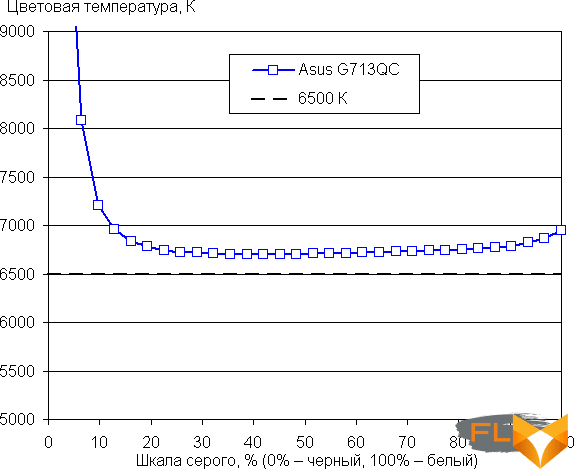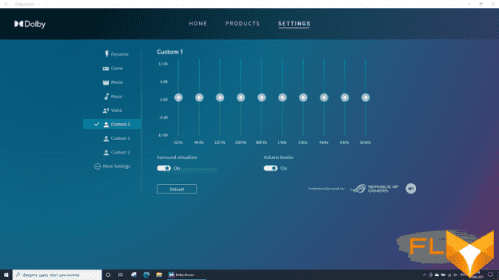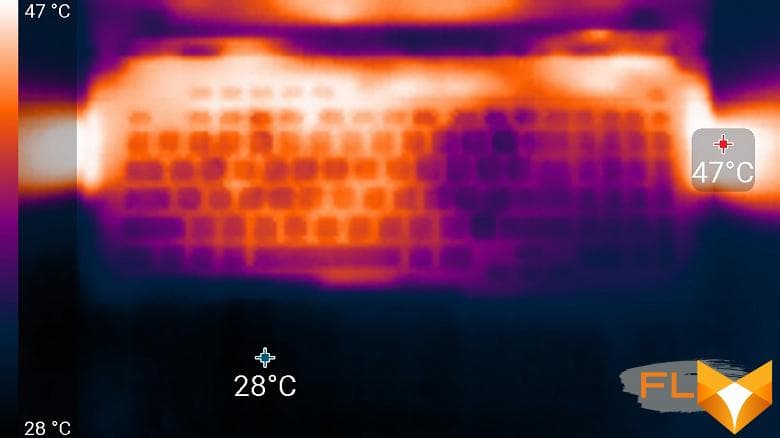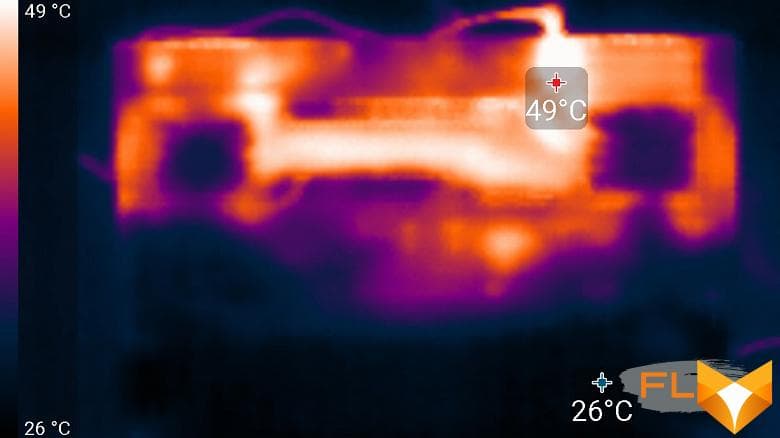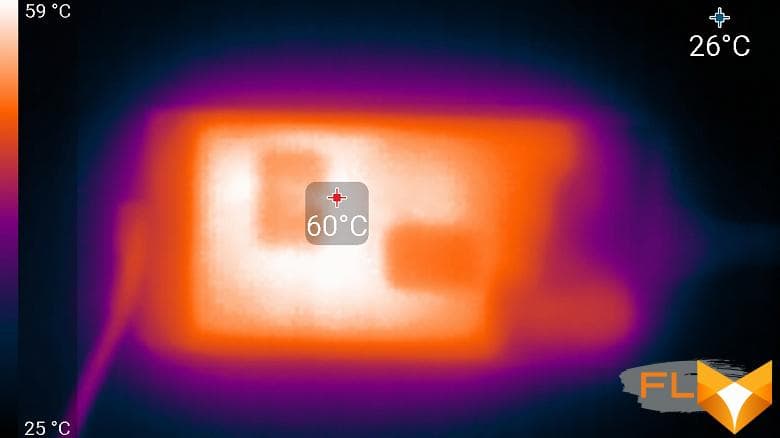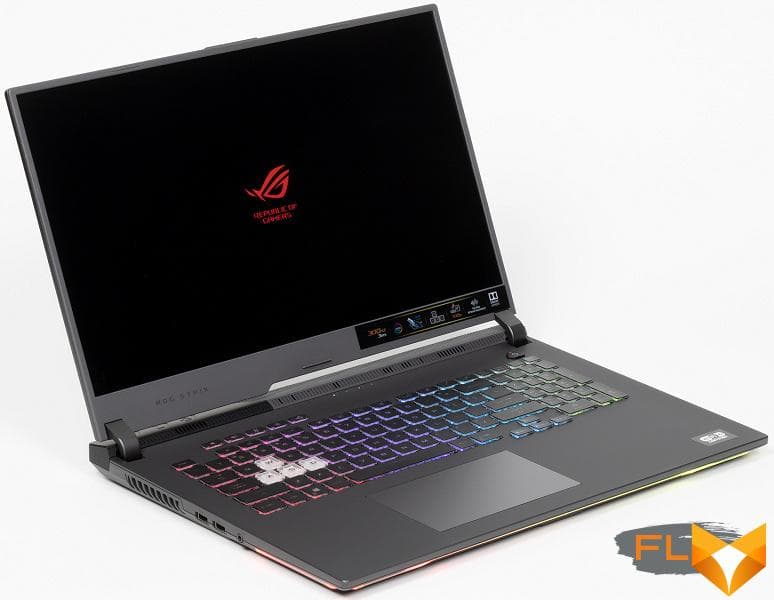


The family of Asus ROG Strix gaming laptops with 17-inch screens has been replenished with another model – with the G713QC index. Its difference lies in the new Nvidia GeForce RTX 3050 graphics card, which was announced on May 11, 2021 as a budget gaming solution, therefore it is inferior to other Nvidia GeForce RTX 30 in terms of specifications and performance, has only 4 GB of video memory, less the number of CUDA, tensor (Tensor AI) and tracing (RT) cores. But the cost of the GeForce RTX 3050 mobile video solution should also be significantly lower than all other Nvidia GeForce RTX 30 video cards, and this allows manufacturers to lower the prices of gaming laptops.
For comparison, we place below a table of characteristics of the Nvidia GeForce RTX 30 Mobile, gleaned (except for prices) on the website of the manufacturer of laptop video cards.
| GeForce RTX model | 3050 | 3060 | 3070 | 3080 |
|---|---|---|---|---|
| Number of CUDA cores | 2048 | 3840 | 5120 | 6144 |
| Number of tensor cores | 64 | 129 | 160 | 192 |
| Number of trace cores | 16 | 30 | 40 | 48 |
| Frequency acceleration, MHz | 1057-1740 | 1283-1703 | 1290-1620 | 1245-1710 |
| Consumption, W | 35-80 | 60-115 | 80-125 | 80-150+ |
| Amount of video memory, GB | 4 | 6 | 8 | 8 or 16 |
| Video memory bus, bit | 128 | 192 | 256 | 256 |
| Price, USD* | less than 180 | 329 | 499 | 699 |
* indicative data; Nvidia does not officially announce pricing for mobile graphics cards.
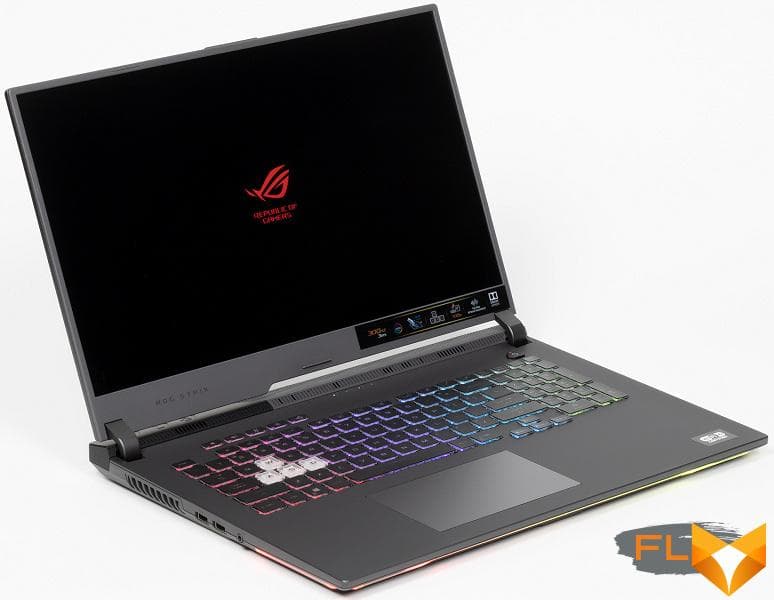
We will test a model that, in addition to the mentioned discrete graphics card, has a powerful AMD Ryzen 7 5800H processor, 32 GB of RAM and a 1 TB SSD. We got not a serial sample, but an engineering sample, which has no Cyrillic characters on the keyboard, Windows 10 Professional is installed instead of Windows 10 Home and has other features. For the same reason, we cannot quote the price of the specimen we tested. All other detailed specifications are listed below.
Configuration and equipment
| Asus ROG Strix G17 G713QR-HG022T | ||
|---|---|---|
| Processor | AMD Ryzen 7 5800H (8 cores/16 threads, 3.2/4.4GHz, 45W) | |
| RAM | 32 GB DDR4-3200 (2 Samsung M471A2G43AB2-CWE SO-DIMMs); Only 16 GB can be installed | |
| Video subsystem | Integrated Graphics: AMD Radeon RX Vega 8 discrete graphics: Nvidia GeForce RTX 3050 Laptop with 4GB GDDR6 Nvidia GeForce RTX 3050 Ti Laptop with 4GB GDDR6 available | |
| Screen | 17.3″ 1920×1080 IPS semi-matte 300Hz 3ms response 100% sRGB 75% Adobe RGB | |
| Sound subsystem | Realtek ALC289 codec, Dolby Atmos, 2 x 4W speakers (Smart Amp Technology) | |
| Accumulators | SSD 1TB (SK Hynix HFM001TD3JX013N, M.2) You can install a second M.2 SSD | |
| Optical drive | none | |
| Cardreader | none | |
| Network interfaces | Wired network | Gigabit Ethernet (Realtek RTL8168/8111) |
| Wi-Fi network | Intel Wi-Fi 6 AX200 (802.11ax, 2×2, channel width up to 160 MHz) | |
| Bluetooth | Bluetooth 5.1 (Dual Band) | |
| Interfaces and Ports | USB | 3 USB3 Gen2 Type-A + 1 USB3 Gen2 Type-C (supports DisplayPort 1.4 graphics output and Power Delivery) |
| RJ-45 | is | |
| Video outputs | 1 HDMI 2.0b + 1 DisplayPort (USB Type-C) | |
| Audio outputs | 1 combo (3.5mm mini jack) | |
| Input Devices | Keyboard | with configurable individual per-key backlighting (per key RGB) and number pad |
| Touchpad | clickpad | |
| VoIP | Webcam | none |
| Microphone | Intelligent Noise Canceling Microphone | |
| Battery | 56 Wh | |
| Dimensions | 395×282×28 mm (thickness without legs – mostly 23 mm) | |
| Weight without power supply | 2.44 kg | |
| Power adapter | 200W 487g with 1.8m cable | |
| Operating system | Windows 10 Professional* | |
* in the tested sample. Asus ROG Strix production models come with Windows 10 Home.
Rough estimates suggest that using an Nvidia GeForce RTX 3050 Laptop with 4GB of VRAM is a $1,100 price advantage over the Asus ROG Strix G713QR (AMD Ryzen 9 5900HX, Nvidia GeForce RTX 3070 Laptop with 8GB of VRAM, 16GB of RAM and an SSD) 1 TB drive). However, even the representatives of the manufacturer could not give us exact data.
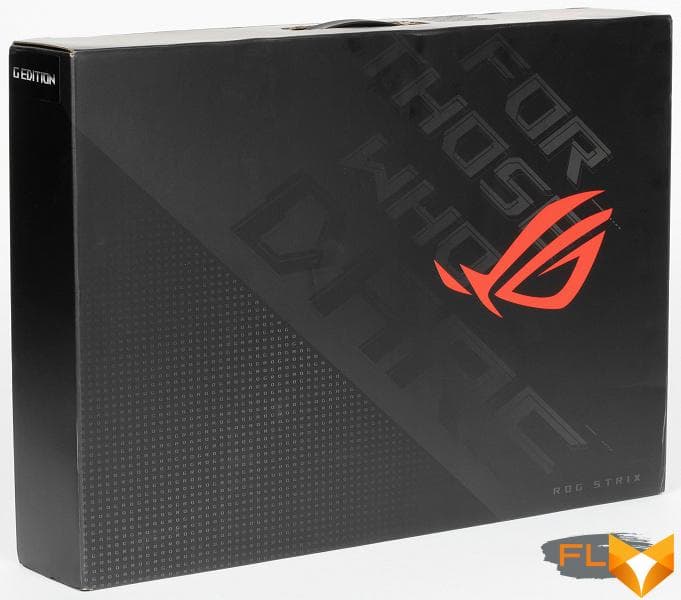
The packaging of the laptop is a black suitcase with a plastic carrying handle. Inside there are separate containers for storing the power adapter and accessories not included with the laptop (mouse, headset, etc.). All this can be carried in one piece of luggage.
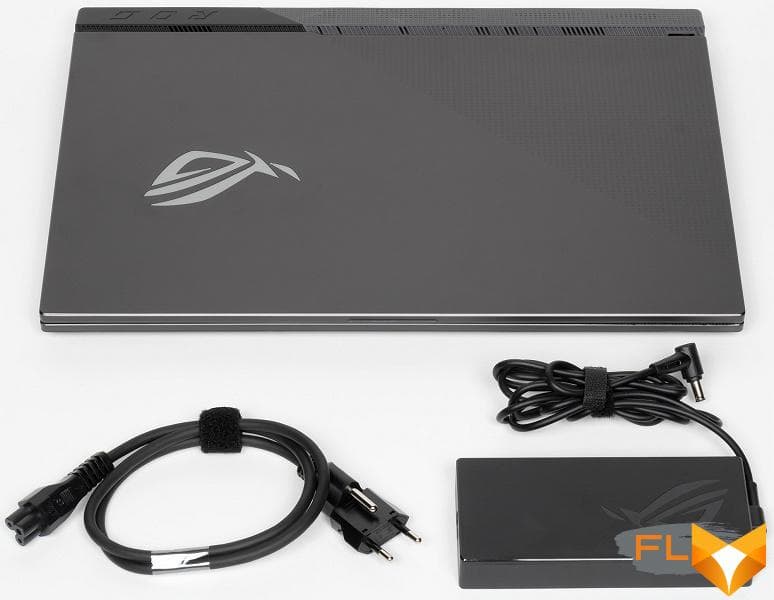
In addition to the machine itself, a heavy (487 g) power adapter is found in the package, which is suitable for operation from an AC mains of 50-60 Hz at a voltage of 100-240 V and provides an output of 20 V at a current of 10 A (power 200 W).
Appearance and ergonomics
On the lid of the Asus ROG Strix G17 G713QC, the ROG logo stands out, which looks like a mirror when not in use, and fills with a soft white glow in the working state.

The laptop has a large 17-inch screen, so the machine could not be compact: length and width – 395 × 282 mm. But the thickness of 23 mm (excluding supports) is quite small. The metal that provides the strength of the case components and the efficiency of the cooling system causes a hefty weight (2.44 kg).
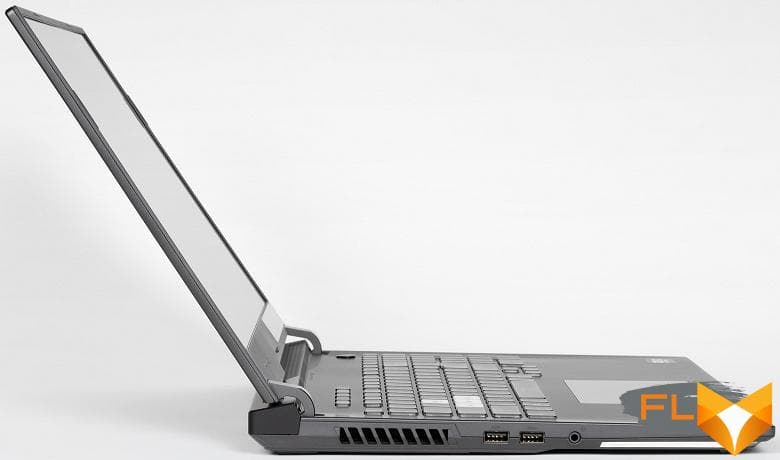
The cover is metal, gray-black, matte. Fingerprints on it are not formed as easily as on a glossy surface, and are erased even easier. The lower right corner of the lid is filled with an array of microletters of the ROG acronym, almost indistinguishable to the naked eye and appearing to be just small squares.
The hinges are massive, durable, lifting the lid above the body. The maximum tilt angle of the lid is approximately 120°. In the closed state, the lid is held without a lock or magnet, due to hinges and a closer, but it keeps well, since the force required to open it is chosen correctly. The hinges are not too tight; the lid is easy to open with one hand, but it does not dangle, and the body does not bounce.
The bottom has a complex surface relief, which meets the specific needs of acoustics and cooling systems.
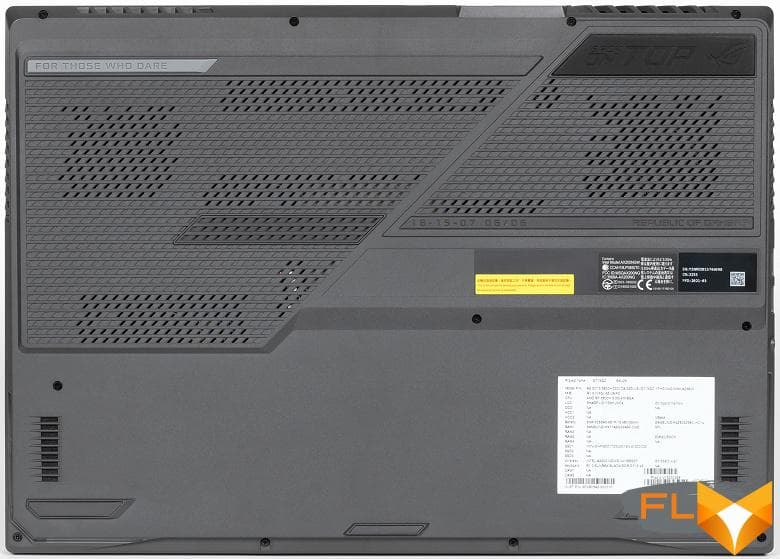
Stroke-like slanted air inlets are located above both coolers, memory modules and the drive. Above the right and left speakers, at the front legs, there are slots for sound output.

On the rear panel, there are grilles of holes through which hot air is thrown out. The left lattice is formed by Roman numerals MMVI, that is, 2006 is the year of birth of the Asus ROG series. Next, there are USB Type A, USB Type C, HDMI connectors, an RJ-45 gigabit network interface connector and a power adapter jack.

On the left side panel there is a grille for the outlet of the cooling system, then two USB Type A connectors, a standard 3.5 mm minijack for connecting headphones or an audio headset, and a backlight light guide.

On the front there is nothing but a small light guide of the laptop lighting system. However, a useful protrusion of the lid is also noticeable, which facilitates its tilting.

There are no connectors on the right side surface; there is only a grille for the outlet of the cooling system and a light guide for illumination.
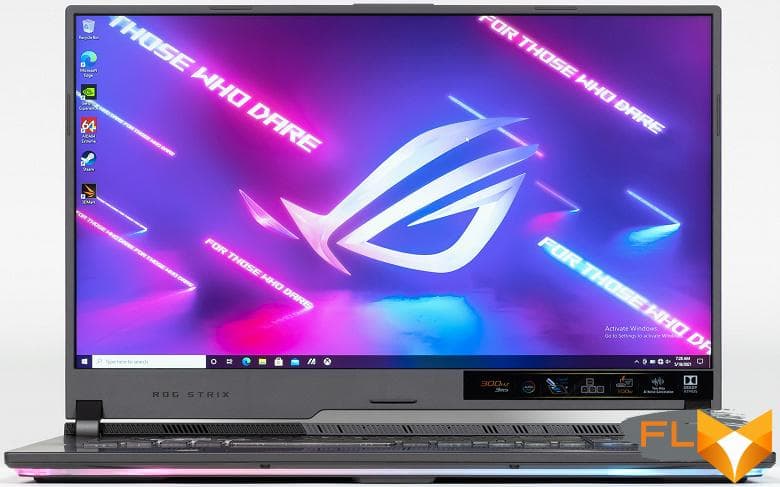
The screen frame on the top, right and left is quite narrow (4.5 mm) and rises above the display surface by only 1.5 mm. The screen is semi-matte, has a size of 17.3 ″ diagonally and is represented by an IPS matrix (1920 × 1080 pixels resolution) with a refresh rate of 300 Hz and a response time of 3 ms – this is quite worthy of a serious gamer. The coverage of the sRGB color space is 100%. Such characteristics make it possible to use the laptop not only for games, but also for working with digital media content of any complexity, from creating web pages and processing photos to editing videos and 3D animation. The laptop does not have a built-in webcam, it would not fit in the narrow frame of the screen. There is no separate camera module in the package. However, this lack is easily filled by offers of more serious external solutions available in abundance.

The user is offered a full-size membrane-type keyboard with a small but tactilely distinct vertical travel of the buttons (about 1.5 mm). In terms of layout and functionality, it roughly corresponds to the standard desktop configuration, except for the navigation area (Insert, Delete. Home, End, Page Up, Page Down), which is replaced by a group of four buttons above the calculator block, as well as navigation arrow keys that can be used in chord with Fn.
Above all, there is a row of five setting buttons: decrease the volume, increase the volume, turn the built-in microphone on and off, change the current performance profile (Silent-Performance-Turbo), launch the Armory Crate application. The last elements are specific to Asus ROG laptops and have no analogues in the standard desktop layout.
The alphanumeric and character keys are rather large (16×16 mm), the distance between their centers is 19 mm, and between the edges is 3 mm. The function buttons are reduced in height (16×9 mm), while the calculator buttons are reduced in width (9×16 mm). The Space key is quite large (91 mm), the width of the right Shift is 44 mm, the left Shift is 39 mm, Backspace and Caps Lock are 30 mm, Enter is 34 mm. The processing of pressings is carried out independently (n-key rollover) – this means that the system will respond to any number of simultaneously pressed buttons.
The function keys (F1-F12) are combined into three fours – it’s easier to find the one you need, especially when the eye is distracted by marking them with symbols corresponding to chords with the “function register” (Fn). The calculator block is designed as usual for users of classic keyboards: large Ins, Enter and “plus”. The block of navigation buttons with arrows is just as traditional.

The four gaming navigation keys (W, A, S, D) are made of translucent plastic with a white backing. When typing and in various non-gaming applications, this prohibitive color accent is unpleasant and sometimes even confusing. It is clear for what purpose this was done, but it is not at all clear to what extent it is justified.
The keyboard is backlit with two levels of brightness (the third state is off), individual for each key (per key RGB). The symbols on the keys themselves and a little of their contours are highlighted. The backlight zone under each key is visible when you deviate from the keyboard, but it glows softly and does not irritate. But the function keys were not lucky: when illuminated, only icons of additional functions in a chord with Fn are visible on them.
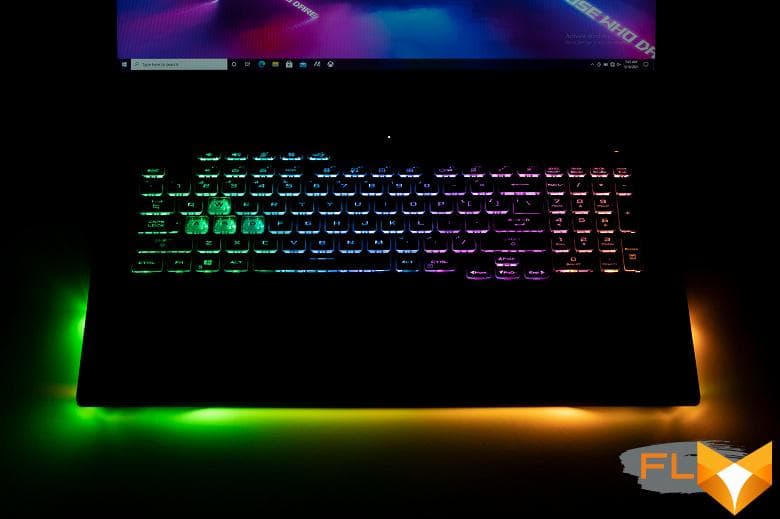
The backlight modes are configured in the proprietary Armory Crate application, which is quickly accessed by pressing the first button on the right in the topmost row of the keyboard with the ROG logo printed on it.
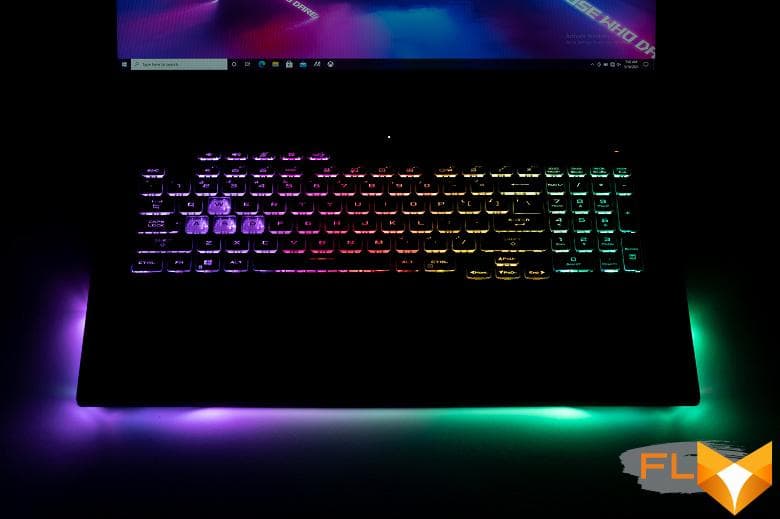
Synchronously with the keyboard, the body of the laptop and the surface on which it is located are illuminated from three sides. This is realized thanks to the plastic light guide insert on the front and sides. Illumination mode corresponds to Aura profiles (chord call Fn+F4):
- Rainbow (colors move in waves from left to right),
- Static (all keys glow continuously in the same color),
- Breathing (smooth increase and decrease in the brightness of a single-color backlight),
- Strobing (quick single color flashes),
- Color Cycle (the color of the entire keyboard smoothly changes – red, orange, yellow, green, cyan, blue, purple).
The proprietary Armory Crate utility has a backlight control that allows you to select one of the ready-made presets and change its parameters. It is also possible to quickly cycle through the schemes and change the brightness of the backlight directly from the keyboard.

For fans of modding, the set of standard applications includes the Aura Creator utility, where the creation of your own lighting scenarios is taken to an even higher level.
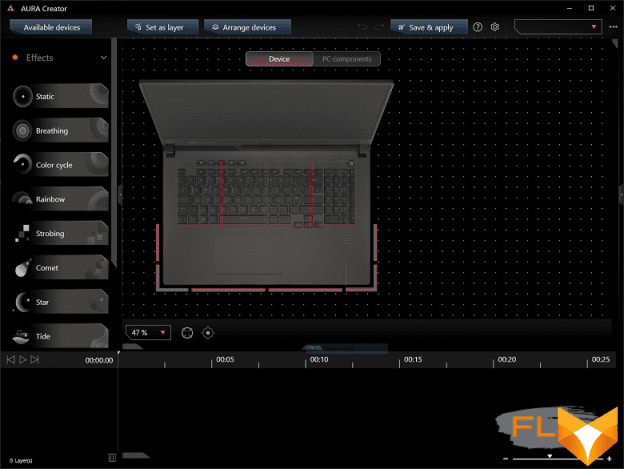
We emphasize that using proprietary utilities, you can synchronize the backlighting of all Asus components with Aura support, in this case it may be relevant, say, to combine headsets, mice, etc. into a single light space with a laptop.

In the Aura Creator application, this is done by simply combining the desired devices or their components.
The navigation bar is not a classic touchpad, but a clickpad, without dedicated buttons, but pressing is accompanied by distinct clicks and corresponding responses. The clickpad is not very big, but easy to use.
Removing the bottom cover, we get access to the cooling system, RAM modules, solid state drive and battery. The user can change the qualitative and quantitative content of the RAM and M.2 slots, as well as replace the battery. The latter, of course, is attached to the case with screws, but it is removed and installed without much hassle.

The cooling system uses the internal volume with maximum efficiency, and the movement of air flows in it occurs simultaneously in six directions. Relatively cold outside air enters through holes in the bottom and top panel (where the latter has an elevation), and hot air is emitted by two fans through four radiators and their grilles (two back, one to the right, one to the left).

Heat is removed by four heat pipes: one from the CPU (left), one from the GPU (right) and two common to the CPU and video card. Thanks to the latter circumstance, both coolers operate in a single thermal circuit, and the fans work in concert when a load is applied to both the central and graphics processors.
The basis of the CPU thermal interface is liquid metal (more precisely, an alloy that remains liquid at processor operating temperatures). This solution allows you to get an additional gain in cooling efficiency and, therefore, has been used in overclocking practice for a long time. Asus announced the robotic application of liquid metal to its laptop processors on April 2, 2020. Initially, this process was used for configurations based on Intel processors, and from early 2021 on systems based on AMD processors.

The laptop has a maximum possible amount of RAM 32 GB. The RAM operates in dual-channel mode, since it is located in two slots with equivalent modules of 16 GB each.
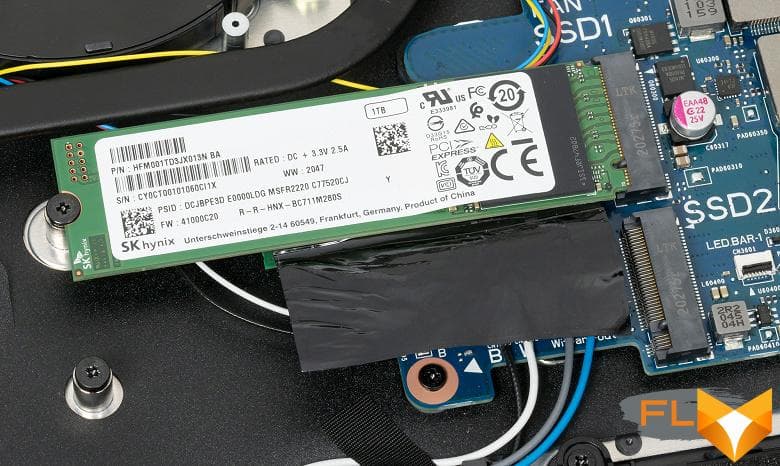
The solid state drive (SSD) in the M.2 slot, on the contrary, is one. Its raw capacity is 1 TB, and in the working configuration (with service partitions) – 930 GB. After deploying Windows 10 and the standard set of applications, the user is left with 880 GB. However, the motherboard has an M.2 slot for a second SSD, which can be used for upgrades, including building RAID0 (stripe) or RAID1 (mirror) arrays.
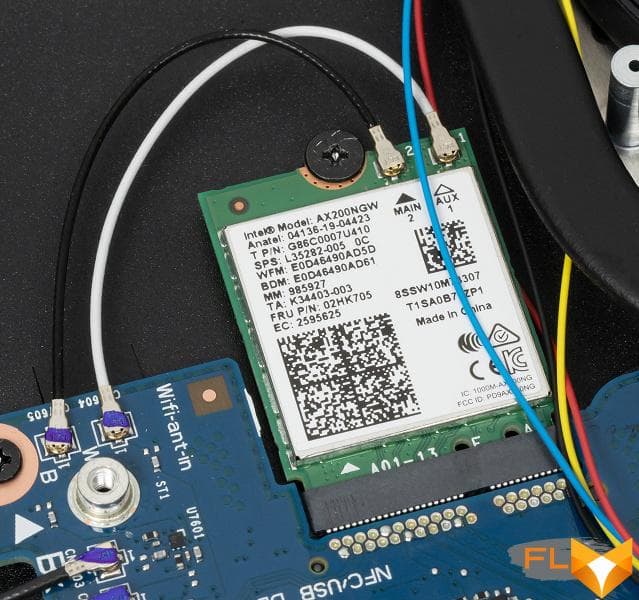
Beneath the first (occupied) SSD slot is an Intel Wi-Fi 6 AX200 (802.11ax) wireless adapter that operates up to 160 MHz channel width.
Software
The laptop comes with a licensed Windows 10 Home operating system, a trial version of Microsoft Office, a set of proprietary utilities and other applications.

The first of them – MyAsus – is a guide to the system, a set of diagnostic tools, a collection of technical support contacts and frequently asked questions. In addition, MyAsus allows you to detect the presence of driver updates and branded applications. In terms of hardware settings, it provides the ability to enable the battery life extension mode by not fully charging it (see below for more details).
The Armory Crate app is responsible for setting up hardware components. This utility can be launched by pressing the fifth button from the left in the topmost row of the keyboard. The most important and useful feature of Armory Crate is the selection of work presets (profiles) that determine the performance and intensity of the laptop cooling system coolers. Of the additional features, we note the output of information about the operation of the fans and monitoring of low-level parameters.
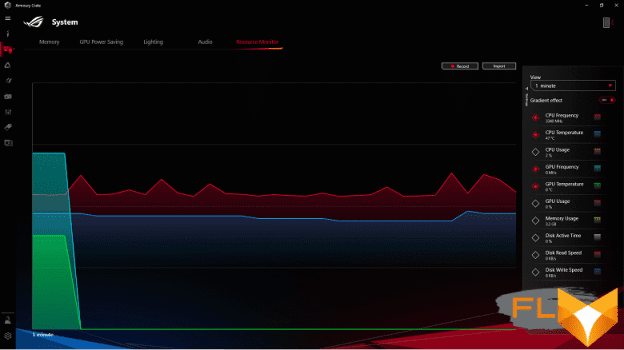
The application has three main settings profiles: Silent, Performance and Turbo. In addition to these, there are also Windows (control is transferred to the operating system) and Manual (manual settings).
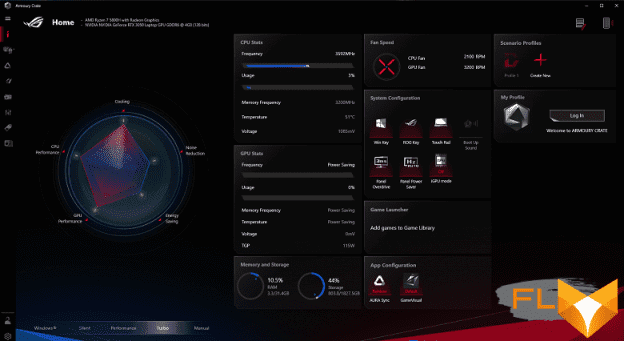
We will consider the features of the laptop in accordance with the three main profiles in the section on testing the laptop under load.
The Manual profile allows you to manually build a cooler response curve to CPU and GPU heating, and additionally overclock the video card and its memory. It also offers adjustment of CPU consumption limits, SPL and SPPT. This is a very valuable tool for a knowledgeable user, nothing like this can be found in ordinary laptops.

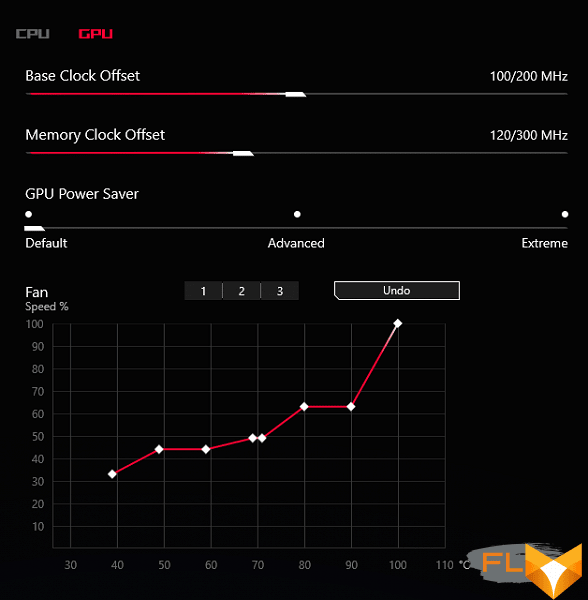
Screen
The Asus G713QC laptop uses a 17.3-inch IPS-matrix with a resolution of 1920 × 1080 pixels.
The outer surface of the matrix is black, hard and semi-matte (mirror is not very pronounced). There is no special anti-reflective coating or filter, and there is no air gap. When powered from the mains or from the battery and with manual brightness control (there is no automatic adjustment by the light sensor), its maximum value was 334 cd / m² (in the center of the screen on a white background). The maximum brightness is quite high, so it will somehow be possible to work / play on the laptop outside on a clear day, if you are at least not in direct sunlight.
To evaluate the readability of the screen outdoors, we use the following criteria obtained from testing screens in real conditions:
| Maximum brightness, cd/m² | Conditions | Readability Score |
|---|---|---|
| Matte, semi-matte and glossy screens without anti-glare | ||
| 150 | Direct sunlight (over 20,000 lux) | illegible |
| Light shadow (about 10000 lux) | barely readable | |
| Slight shade and light clouds (no more than 7500 lux) | uncomfortable to work | |
| 300 | Direct sunlight (over 20,000 lux) | barely readable |
| Light shadow (about 10000 lux) | uncomfortable to work | |
| Slight shade and light clouds (no more than 7500 lux) | work comfortably | |
| 450 | Direct sunlight (over 20,000 lux) | uncomfortable to work |
| Light shadow (about 10000 lux) | work comfortably | |
| Slight shade and light clouds (no more than 7500 lux) | work comfortably | |
These criteria are very conditional and may be revised as data accumulate. Note that there may be some improvement in readability if the matrix has some kind of transreflective properties (part of the light is reflected from the substrate, and the image can be seen in the light even with the backlight turned off). Also, glossy matrices, even in direct sunlight, can sometimes be rotated so that they reflect something fairly dark and uniform (on a clear day, for example, the sky), which will improve readability, while matte matrices need to be blocked from Sveta. In rooms with bright artificial light (about 500 lux), you can work more or less comfortably even with a maximum screen brightness of 50 cd / m² and below, that is, in these conditions, maximum brightness is not an important value.
Let’s return to the screen of the tested laptop. If the brightness setting is 0%, then the brightness is reduced to 15 cd/m². In complete darkness, the brightness of its screen can be lowered to a comfortable level.
At any brightness level, there is no significant backlight modulation, so there is no screen flicker. As proof, here are graphs of the dependence of brightness (vertical axis) on time (horizontal axis) at various values of the brightness setting:

This laptop uses an IPS type matrix. Micrographs show a typical IPS subpixel structure (black dots are dust on the camera’s matrix):

Focusing on the screen surface revealed randomly located surface microdefects, which are responsible for the matte properties:

The grain of these defects is several times smaller than the size of the subpixels (the scale of these two photographs is approximately the same), so the focusing on microdefects and the “jumping” of the focus on the subpixels with a change in the angle of view are weakly expressed, because of this there is no “crystal” effect.
We measured brightness at 25 screen points spaced in 1/6th increments of the screen width and height (screen borders not included). The contrast was calculated as the ratio of the brightness of the fields at the measured points:
| Parameter | Average | Mean Deviation | |
|---|---|---|---|
| min., % | max % | ||
| Black box brightness | 0.31 cd/m² | −18 | 35 |
| White box brightness | 330 cd/m² | −16 | 13 |
| Contrast | 1100:1 | −35 | 6,0 |
Even if you step back from the edges, the variation in the brightness of the black and white fields, as well as the contrast, is high. Contrast by modern standards for this type of matrix is slightly higher than typical (900-1000:1). The photo below gives an idea of the distribution of the brightness of the black field over the screen area:

It can be seen that the black field in some places, mostly closer to the edge, is slightly brightened. However, the uneven illumination of black is visible only on very dark scenes and in almost complete darkness, it should not be considered a significant drawback. Note that the rigidity of the lid, although it is made of aluminum, is low, the lid is slightly deformed at the slightest applied force, and the nature of the black field illumination changes greatly due to deformation. The screen has good viewing angles without significant color shift even at large deviations of the gaze from the perpendicular to the screen and without inverting shades. However, the black field, when deviated diagonally, is strongly highlighted and acquires a slight reddish tint.
The response time depends on the refresh rate and on whether matrix overclocking is enabled in the proprietary utility (Overdrive technology parameter). The diagram below shows how the turn-on and turn-off times change during a black-white-black transition (bars “on” and “off”), as well as the average total time for transitions between grayscales (bars “GTG”) for a refresh rate of 300 Hz :
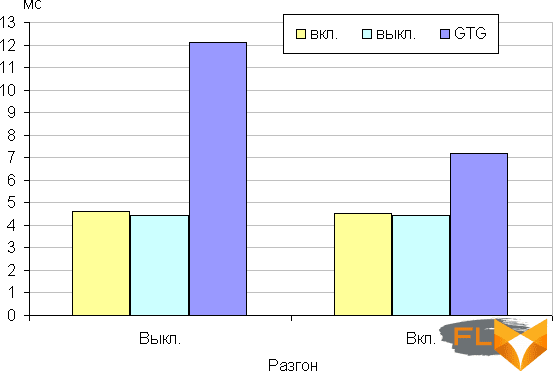
In any case, the matrix is fast. After acceleration, bursts of brightness with a small amplitude appear on the fronts of some transitions (graphs for the transition between shades of gray 70% and 90% according to the numerical value of the color of the hue, brightness is the vertical axis, time is the horizontal axis):
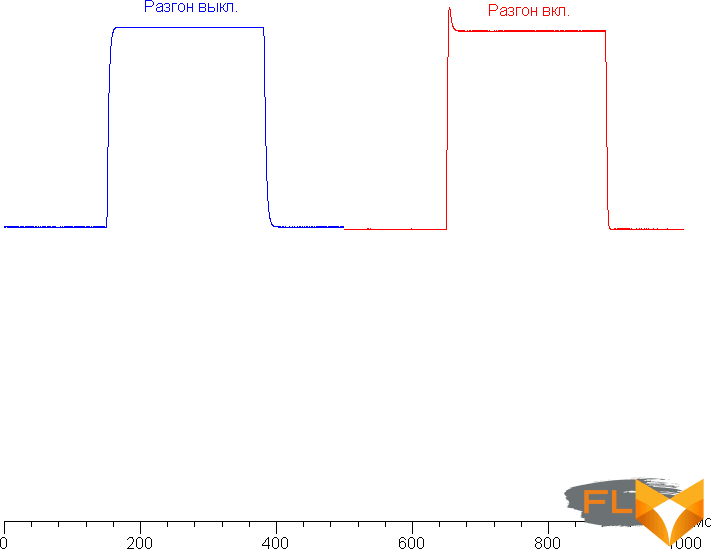
Note that the manufacturer specifies a response time of 3 ms, and, indeed, transitions between some grayscales are performed even in less time.
Let’s see if this matrix speed is enough to display an image with a frequency of 300 Hz. Here is the dependence of brightness on time when alternating white and black frames at 300 Hz frame rate:
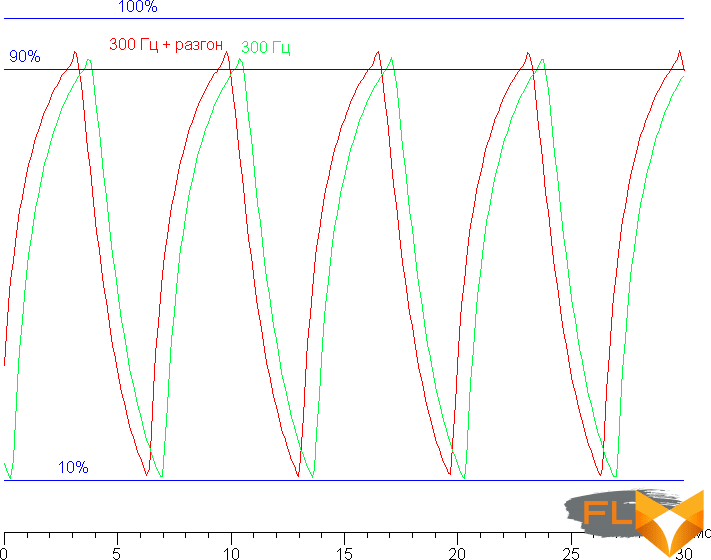
It can be seen that at 300 Hz the maximum brightness of the white frame is above 90% of the white level, and the minimum brightness of the black frame is close to 10% of the white level. The resulting amplitude swing is greater than 80% of the white brightness. That is, according to this formal criterion, the matrix speed is sufficient for a full-fledged image output with a frame rate of 300 Hz.
For a visual representation of what such a matrix speed means in practice, what artifacts from overclocking can be, we present a series of images taken with a moving camera. Such pictures show what a person sees if he follows with his eyes an object moving on the screen. The recommended settings were used (movement speed 960 ppi/s), shutter speed 1/15 s, refresh rates are shown in the photos, and whether overclocking (OD) is enabled.
It can be seen that, ceteris paribus, the image clarity increases with the increase in the refresh rate and the degree of overclocking, but even in the case of overclocking, artifacts are practically not visible.
Let’s try to imagine what would happen in the case of a matrix with instant pixel switching. For it, at 60 Hz, an object with a motion speed of 960 pixels / s is blurred by 16 pixels, at 300 Hz – by 3.2 pixels. Blurred because the focus of vision moves at the specified speed and the subject remains stationary for 1/60 or 1/300 of a second. To illustrate this, let’s simulate a blur of 16 and 3.2 pixels:
It can be seen that the clarity of the image, especially after overclocking the matrix, is almost the same as in the case of an ideal matrix.
We determined the total output delay from switching pages of the video buffer to the start of displaying the image on the screen (recall that it depends on the features of the Windows OS and the video card, and not only on the display). At 300Hz refresh rate (FreeSync enabled) the latency is 4.6ms. This is a very small delay, it is absolutely not felt when working on a PC, and in very dynamic games it will not lead to a decrease in performance.
This laptop supports AMD FreeSync technology. The range of supported frequencies, which is indicated on the settings panel for AMD video cards, is 48-300 Hz. The inclusion of FreeSync allowed us to get an image with smooth movement in the frame and without gaps. However, at 300 Hz refresh rate, the positive effect of FreeSync is minimal.
In the screen settings, two refresh rates are available to choose from – 60 and 300 Hz. At least at native screen resolution, the output is at a color depth of 8 bits per color.
Next, we measured the brightness of 256 shades of gray (from 0, 0, 0 to 255, 255, 255) at default settings (Default profile). The graph below shows the increase (not an absolute value!) in brightness between adjacent halftones:

The growth of the increase in brightness over most of the gray scale is more or less uniform, but in the highlights the monotony of growth is broken and one of the lightest shades does not visually differ from white in brightness. Formally, in the shadows, the brightness grows from black and further, but visually the first two shades of gray are indistinguishable from black:
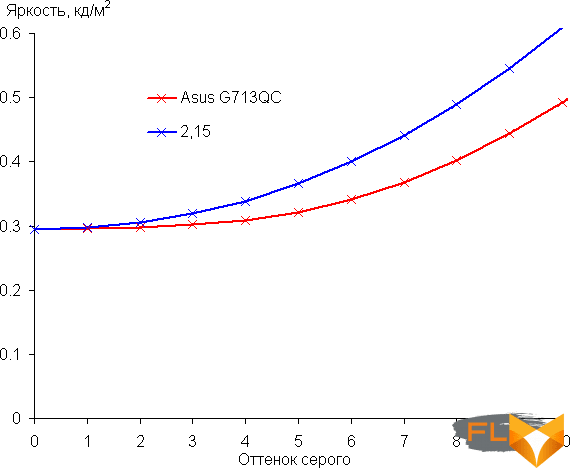
The visibility of the gradation in the shadows can be improved by selecting the appropriate profile on the GameVisual tab.
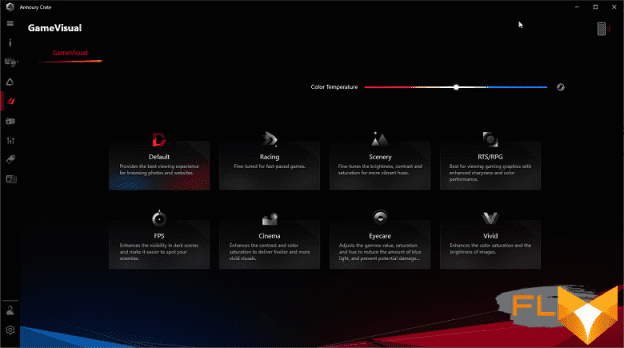
True, in most cases, the blockage of lights increases, which is uncritical for games. Below are gamma curves plotted from 32 points for various profiles:
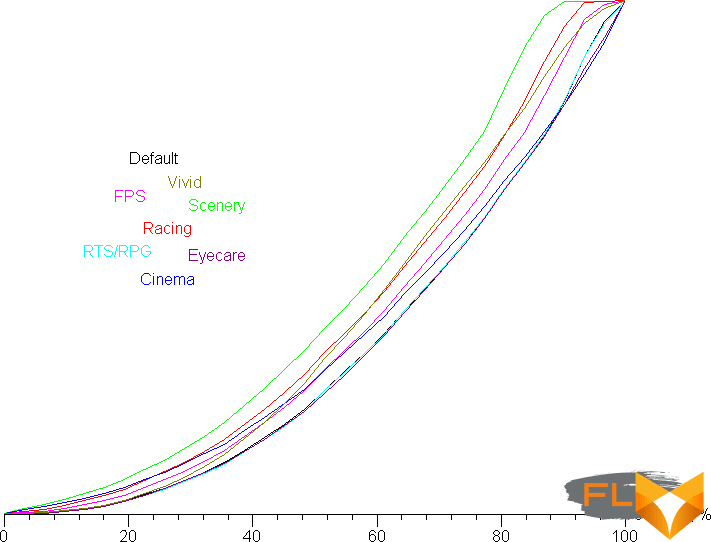
And the behavior of these curves in the shadows:

It can be seen that in the case of profiles in which the growth rate of brightness in the shadows is increased and the visibility of details in the shadows is improved, the black level, and hence the contrast, does not change.
Approximation of the gamma curve obtained for the default settings (Default profile) gave an indicator of 2.15, which is slightly lower than the standard value of 2.2, while the real gamma curve in highlights deviates significantly from the approximating power function:
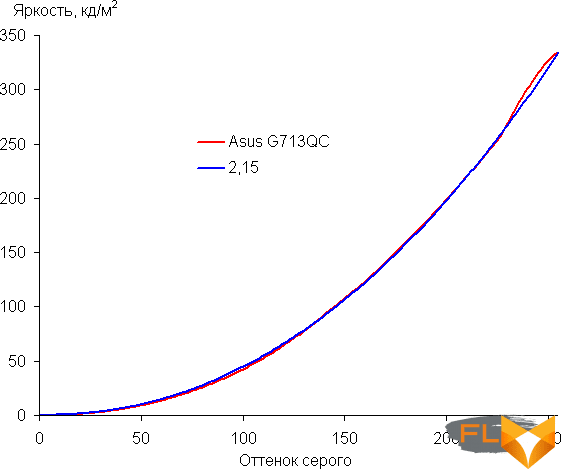
Color gamut close to sRGB:
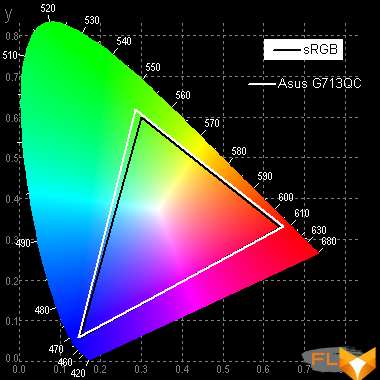
Therefore, visually, the colors of images oriented to output in sRGB space on this screen have a natural saturation. Below is the spectrum for a white field (white line) superimposed on the spectra of red, green and blue fields (lines of the corresponding colors):
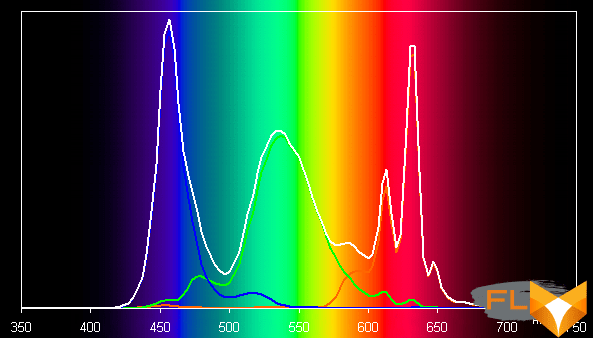
Apparently, this screen uses LEDs with a blue emitter and a green and red phosphor (usually a blue emitter and a yellow phosphor), which in principle allows you to get a good separation of the components. Yes, and in the red phosphor, apparently, the so-called quantum dots are used. However, apparently, specially selected light filters perform cross-mixing of components, which narrows the coverage to sRGB.
The balance of shades on the gray scale in the case of the Default profile selected by default is a compromise, since the color temperature is close to the standard 6500 K, but the deviation from the black body spectrum (ΔE) is much higher than 10, which is considered too big even for a consumer device. If there is something to compare with, then it is clear that the white and shades of gray on this screen slightly go into green. But at least the color temperature and ΔE change little from hue to hue – this has a positive effect on the visual assessment of the color balance (and if there is no standard for comparison). (The darkest areas of the gray scale can be ignored, since the color balance does not matter much there, and the measurement error of color characteristics at low brightness is large.)
Let’s summarize. The screen of this laptop has a high enough maximum brightness (334 cd/m²) to allow the device to be used outdoors on a bright day, shielded from direct sunlight. In complete darkness, the brightness can be reduced to a comfortable level (up to 15 cd / m²). The advantages of the screen include a high refresh rate (300 Hz), while the matrix speed is enough to display an image with such a frequency and without artifacts; the ability to select profiles in which the visibility of details in the shadows increases; low output latency (4.6 ms with FreeSync enabled) and color gamut close to sRGB. The disadvantages are the low stability of black to the deviation of the gaze from the perpendicular to the plane of the screen. In general, the screen quality is high, and in terms of screen properties, the laptop can reasonably be classified as a gaming laptop.
Sound
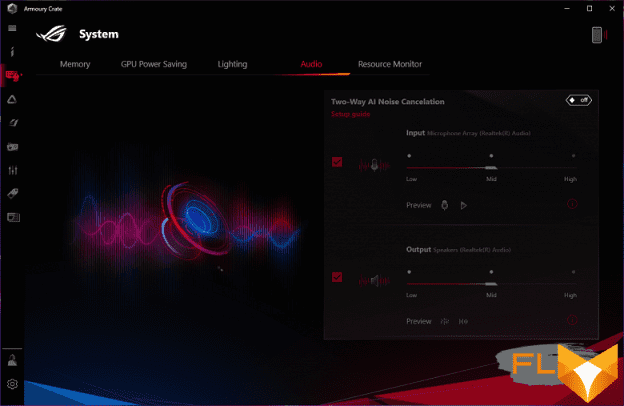
The laptop’s audio system is based on the Realtek codec, basic settings are made from its proprietary control panel. The laptop has 2 speakers, which are located on the bottom of the case near the front edge. To adjust the sound parameters, the Dolby Access utility is preinstalled, which allows you to switch profiles, enable and disable virtualization effects, and manually adjust the parametric equalizer. Also, Dolby technologies are designed to “clean” the sound recorded from microphones from interference and background noise to make it more pleasant to communicate. The sound of the speakers is subjectively pleasant, without obvious problems such as wheezing at maximum volume.
The loudness of the built-in loudspeakers was measured while playing an audio file with pink noise. The maximum volume was 66.0 dBA, so among the laptops tested at the time of this writing (minimum 64.8 dBA, maximum 83 dBA), this laptop is one of the quietest.
| Model | Loudness, dBA |
|---|---|
| MSI P65 Creator 9SF (MS-16Q4) | 83 |
| Apple MacBook Pro 16″ | 79.1 |
| Huawei MateBook X Pro | 78.3 |
| HP ProBook 455 G7 | 78.0 |
| MSI Alpha 15 A3DDK-005RU | 77.7 |
| Gigabyte Aero 15 OLED XD | 77.3 |
| Asus ROG Zephyrus S GX502GV-ES047T | 77 |
| Apple MacBook Air (Early 2020) | 76.8 |
| MSI Stealth 15M A11SDK | 76 |
| Asus ZenBook Duo UX481F | 75.2 |
| Gigabyte Aero 15 OLED XC | 74.6 |
| Dell Vostro 7500 | 74.4 |
| Asus GA401I | 74.1 |
| Honor MagicBook Pro | 72.9 |
| Huawei MateBook D14 | 72.3 |
| Asus VivoBook S15 (S532F) | 70.7 |
| MSI Stealth 15M A11UEK | 70,2 |
| Lenovo IdeaPad L340-15IWL | 68.4 |
| Lenovo IdeaPad 530S-15IKB | 66.4 |
| Asus ROG Strix G17 G713QC | 66.0 |
Battery life

The total capacity of rechargeable batteries in the notebook is 56 Wh. In order to get an idea of how this indicator correlates with battery life in practice, we conduct testing according to our methodology. The screen brightness during testing is set to 100 cd/m² (in our case, this corresponds to about 40% of the screen brightness).
| Load Scenario | Opening hours |
|---|---|
| Working with text | 7 hours 4 minutes |
| View video | 5 hours 1 minute |
When running on battery power with text (or, for example, when browsing Internet pages without heavy scripts to execute), the Asus ROG Strix G17 G713QC is able to serve the user from one full charge for more than 7 hours, so you can take it with you to work or to a meeting without power adapter (if during this period it is not supposed to work for a long time in applications that are demanding on hardware resources and power consumption. You can watch offline video for 5 hours. In general, these are average indicators.
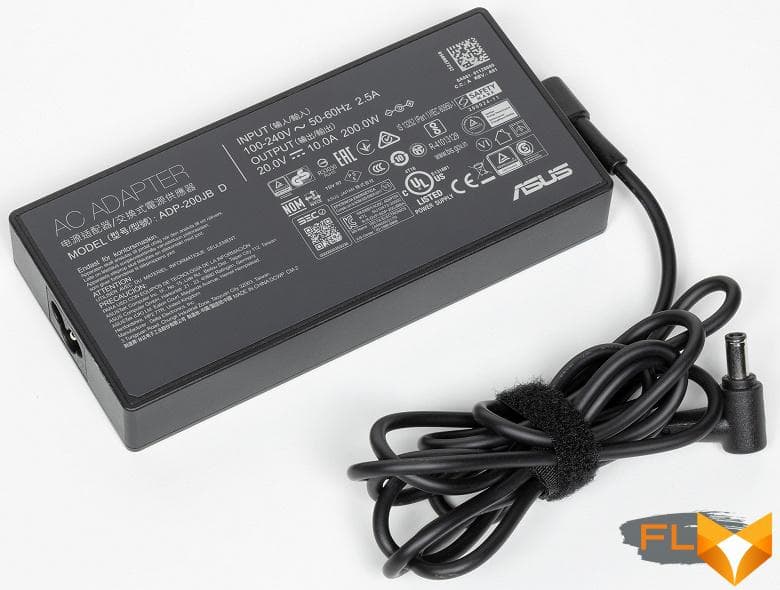
The time to fully charge the laptop battery from the main standard adapter is approximately 1 hour 42 minutes. Below is a charging schedule (measurements at 1 minute intervals).
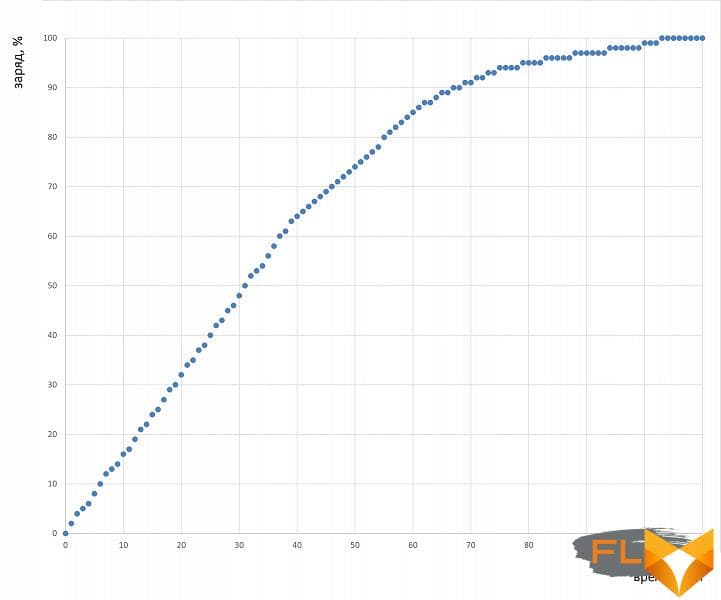
In the initial period, the process goes faster: in the first half hour, 48% of the charge is gained, in 40 minutes – 64%, in 1 hour – 85%. Then there is a slowdown: 1 hour 10 minutes – 91%, 1 hour 30 minutes – 97%.
In the proprietary MyAsus utility, you can turn on the battery life extension mode by choosing how much to undercharge the battery, in accordance with the typical laptop usage profile.
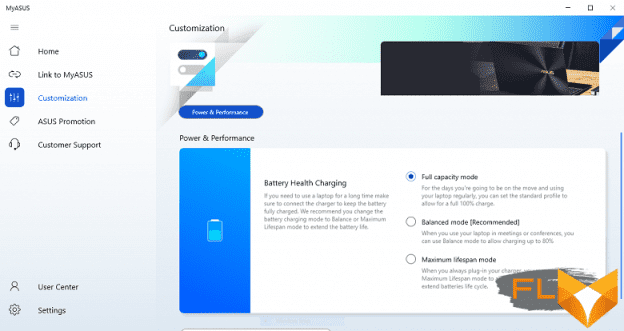
The corresponding LED on the case lights up orange when charging (up to 95%) and white when working, when the discharge is below 10% it starts blinking orange.
Load operation and heating
As mentioned above (in the description of the machine design), its coolers have two common heat pipes that contact the CPU and GPU at the same time, so we can say that they are combined into one circuit. For this reason, the fans turn on and run more or less in sync when both the CPU and GPU are under load.
Load tests were carried out by us indoors at an ambient temperature of 20 °C. We summarized the operating parameters of the system components in a general table, which is presented below. In it, through a fraction, the maximum and steady-state values are indicated, and through a dash, the ranges of parameter variability.
| Load Scenario | CPU Frequencies, GHz | CPU temperature, °C | CPU Watts | GPU and memory frequencies, MHz | GPU temperature, °C | GPU Wattage | Fan speed (CPU/GPU), RPM |
|---|---|---|---|---|---|---|---|
| Silent Profile | |||||||
| Inactivity | 49 | 5 | 42 | 6 | 0/0 | ||
| Max CPU load | 2.82/2.55-2.08 | 72/65 | 45/35-25 | 2100/3000 | |||
| Maximum GPU load | 1400-1200 11000 | 63 | 75/44-38 | 2100/3000 | |||
| Maximum CPU and GPU load | 2.68/2.52-2.04 | 78/68 | 44/35-25 | 1500-1200 11000 | 69/67-61 | 61/41-38 | 4200/4000 |
| Performance Profile | |||||||
| Inactivity | 50 | 6 | 48 | 6 | 0/0 | ||
| Maximum CPU load | 3.03/2.87 | 78/75 | 56-37 | 4500/4600 | |||
| Maximum GPU load | 1800 12000 | 73 | 86/84 | 4500/4600 | |||
| Maximum CPU and GPU load | 2.37/2.22 | 85 | 38/35 | 1800-1600 12000 | 76 | 78/70 | 4600/4600 |
| Turbo Profile | |||||||
| Inactivity | 52 | 6 | 43 | 6 | 0/0 | ||
| Max CPU load | 3.00/2.83 | 75 | 55/48-32 | 4500/4600 | |||
| Maximum GPU load | 1900 12000 | 78 | 95 | 5300/5300 | |||
| Maximum CPU and GPU load | 2.37/2.08 | 87 | 36/33-28 | 1900 12000 | 82 | 98/96 | 5300/5300 |
Turbo Profile
In idle mode at the specified ambient temperature, the fans may not rotate at all. When the ambient temperature rises to 23 ° C after 15-17 minutes, they can spin up to 3000 rpm, while creating a noise of 27 dBA, but after 2-3 minutes they turn off again.
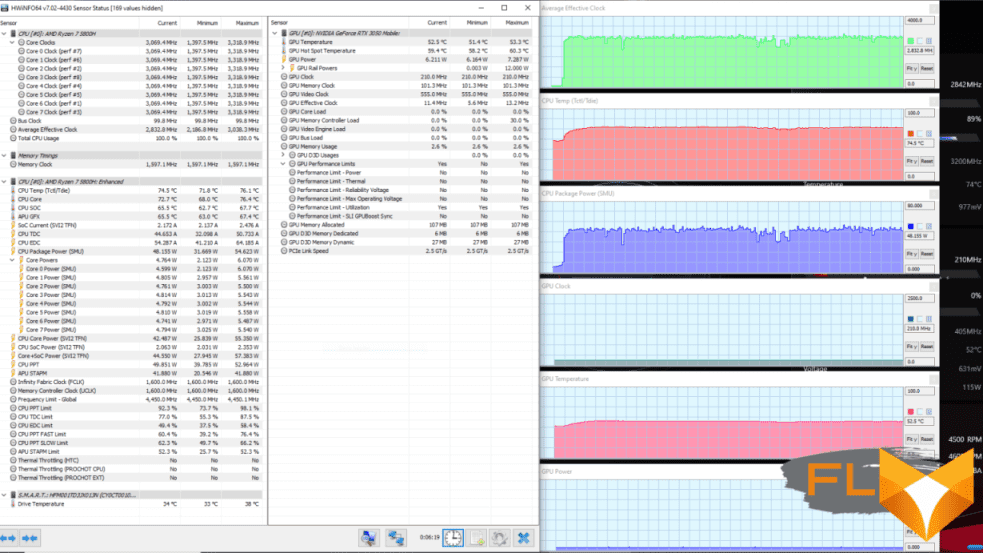
At maximum load on the central processor, its frequency reaches 3 GHz in peaks, on average it is kept at around 2.83 GHz with periodic drops to 2.19 GHz. The maximum consumption is 55 watts with drops to 32 watts from time to time. CPU/GPU coolers spin up to 4500/4600 rpm in a minute, creating a noise of 39 dBA, and operate at a constant speed. The processor temperature is kept at 75 °C. Overheating is not observed.
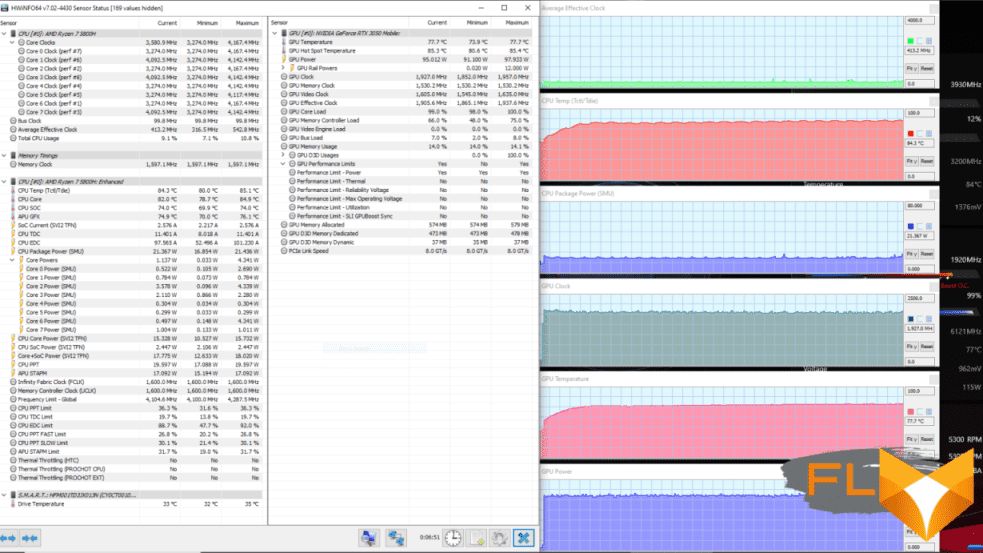
At maximum load on the video processor, the latter operates at a frequency of 1.9 GHz and consumes 95 watts, which exceeds the upper limits of the range declared by Nvidia for the GeForce RTX 3050 Laptop video card (1.74 GHz and 80 watts). This happens as a result of automatically enabling ROG Boost GPU Overclock technology under conditions of almost 100% load on the graphics card. The screenshot shows confirmation: the “tail” of the red slider (this is in itself a symbol of a working overclocking) and the letters “Boost O.C.” on the black background of the Armory Crate window under the figures for the frequency of the video card 1920 MHz. The CPU/GPU fans spin up to 5300 rpm (noise 44 dBA) and then run at a constant speed. The temperature of the video processor is stably kept at around 78 °C, no overheating is observed.
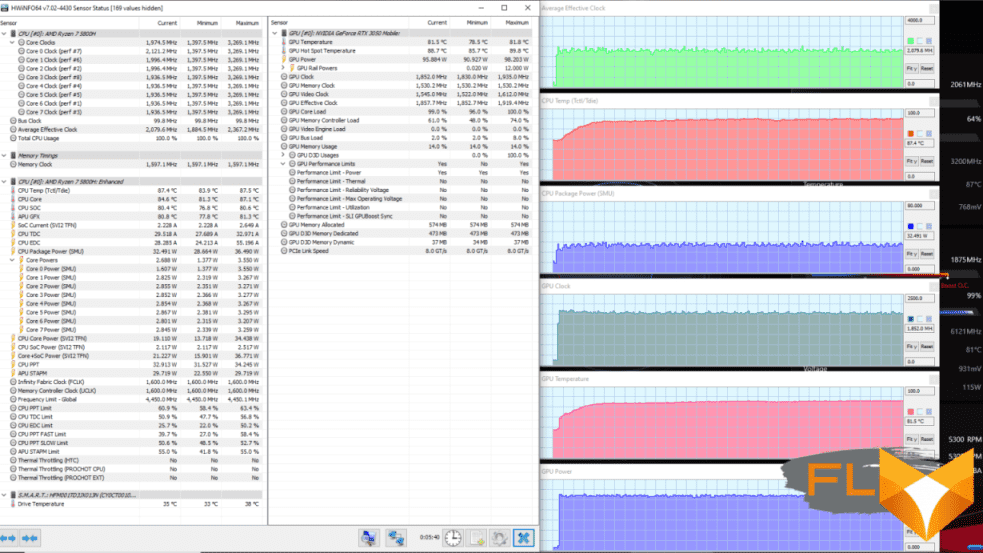
At maximum load simultaneously on the processor and video card, their consumption reaches 36 and 98 W, respectively, at frequencies of 2.37 GHz and 1.9 GHz, and the temperature is 87 °C and 82 °C. Again, the performance of the video card goes beyond the upper limits of the passport values thanks to the inclusion of ROG Boost GPU Overclock. Both fans quickly accelerate to 5300 rpm (noise 44 dBA) and constantly run at the reached speed.
Performance Profile
In idle mode, the laptop is able to work with passive cooling for up to 10 minutes. Then the CPU / GPU fans spin up to 2200 rpm (25 dBA), run like this for a couple of minutes and turn off again. In terms of noise level, these are quite comfortable indicators.
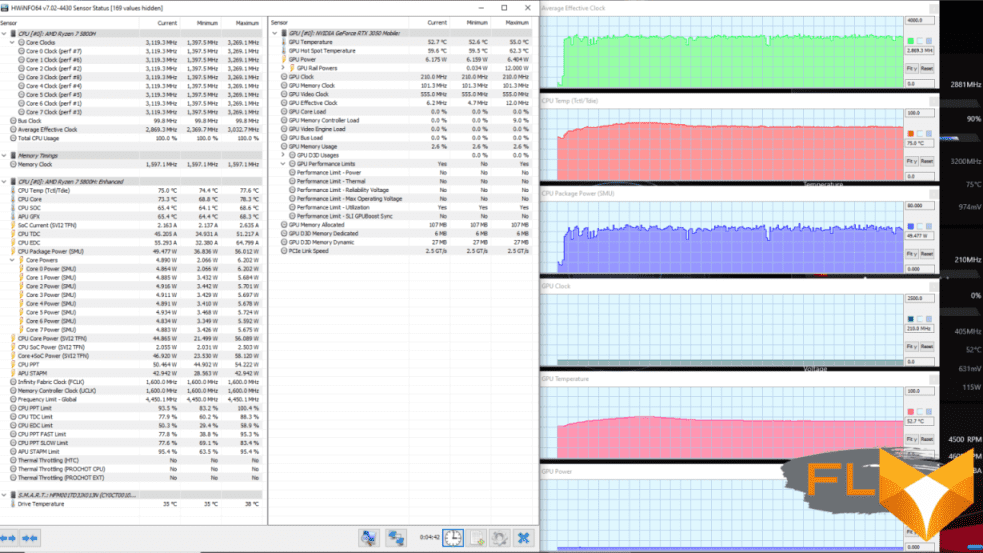
At maximum load on the central processor, its frequency reaches 3 GHz, and the consumption is 56 W, but periodically there are frequency drops down to 2.4 GHz with a decrease in power consumption to 37 W. CPU/GPU coolers spin up to 4500/4600 rpm in a minute, creating a noise of 39 dBA, and operate at a constant speed. The processor temperature first rises to 78 °C (shown on the graph), and after spinning up the coolers it drops to 75 °C and then stays at this level. Overheating is not observed.
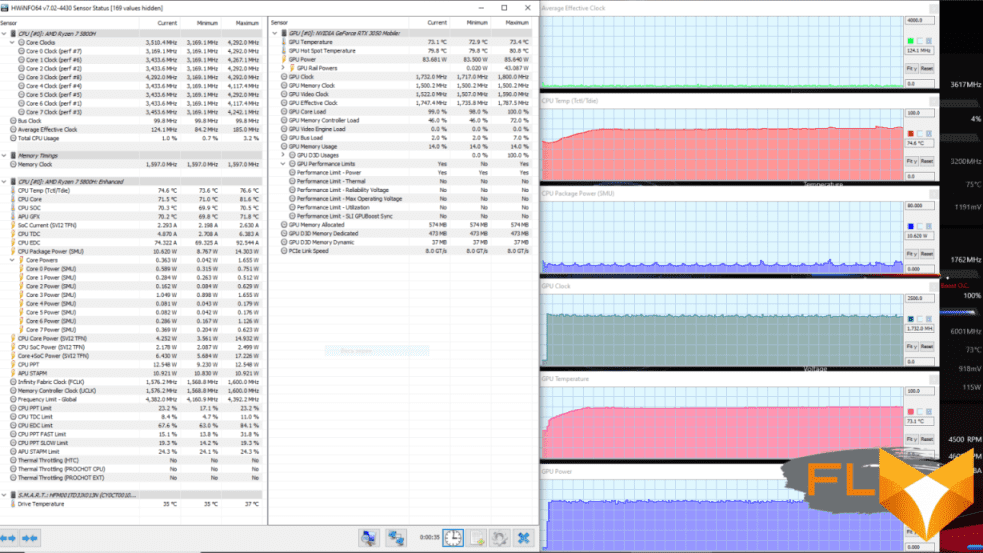
At maximum load on the video card, the GPU frequency is 1.8 GHz at a consumption of 84-86 W and a temperature of 73 °C. ROG Boost GPU Overclock turns on, but again, overheating is not observed. The coolers spin up to 4500/4600 rpm (39 dBA) within a minute, and then their rotation speed does not change.
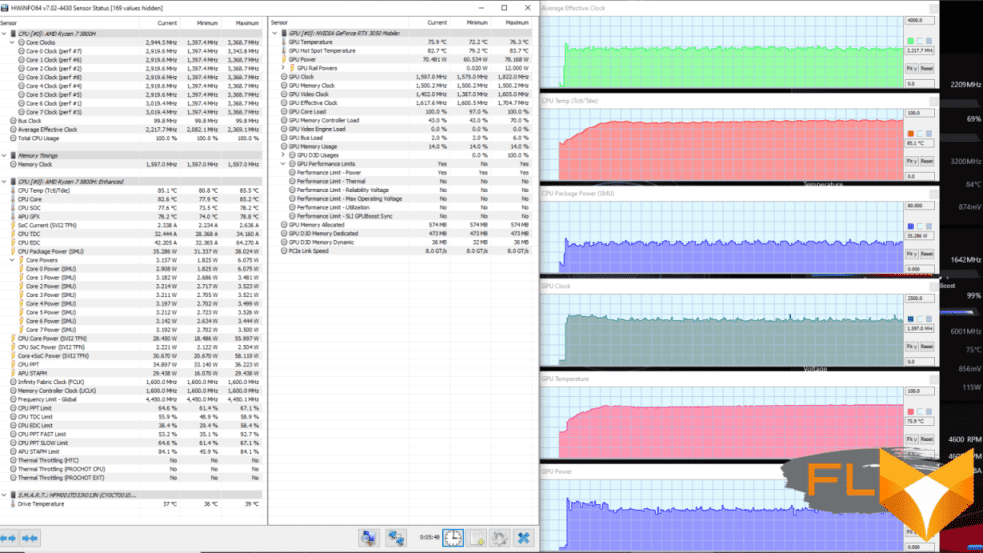
At maximum load on the processor and video card simultaneously, the CPU clock speed varies from 2.22 to 2.37 GHz, consumption – from 35 to 38 W, and temperature – from 84 to 85 ° C. The GPU frequency varies from 1.82 to 1.6 GHz, consumption is from 70 to 78 W, and the temperature is kept between 75 and 76 °C. ROG Boost GPU Overclock turns on, but does not overheat. Fan speeds reach 4600 rpm (44 dBA) within a minute, and then the impellers rotate at constant speed.
Silent profile
When idle, the laptop can run in silent passive cooling mode for about 20 minutes, then the fans accelerate to 2300 rpm (22 dBA) for 30 seconds, and then stop again.
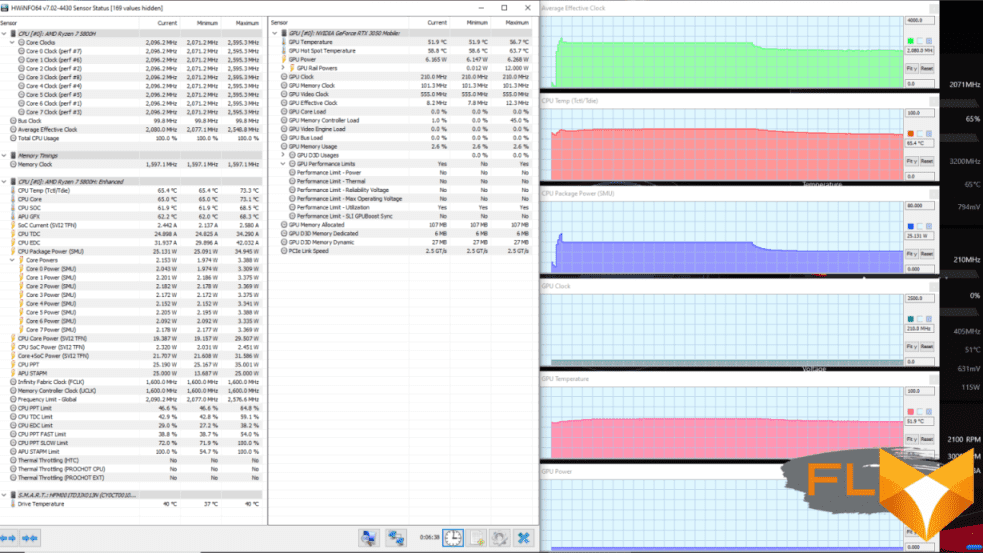
At maximum load on the processor, an initial frequency peak of up to 2.82 GHz and consumption of up to 45 watts is noticeable. Then, for four minutes, the processor clock frequency stays around 2.55 GHz with a consumption of 35 W, and in the fifth minute these figures drop to 2.08 GHz and 25 W, that is, the automatic system prevents both computers from overheating and increasing the noise of the cooling system. The temperature stabilizes at 65 °C. The coolers spin up to 2100/3000 rpm already in the second minute and then work at these speeds.
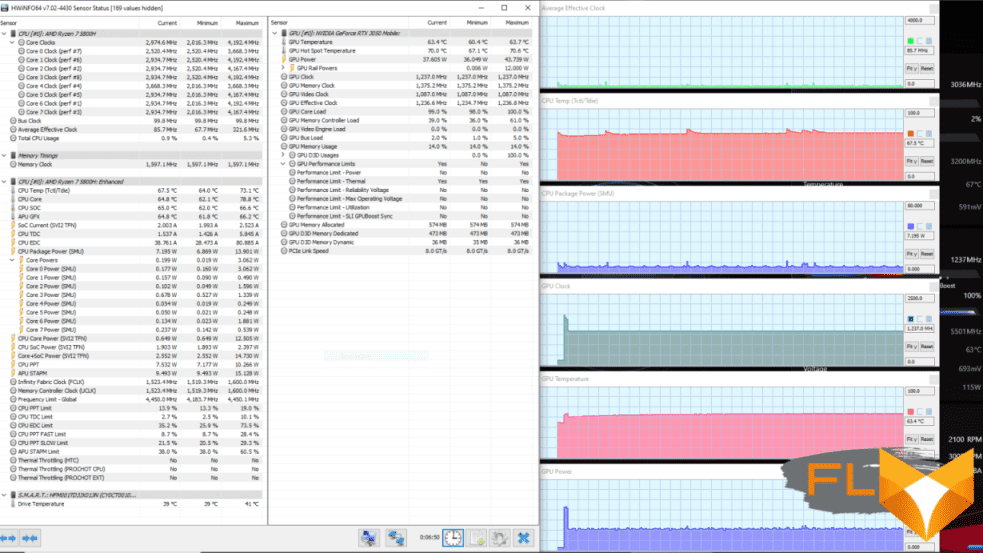
At maximum load on the video card, a short initial burst of frequency (up to 1400 GHz) and consumption (up to 75 W) of the video processor is noticeable. Then the frequency is set at around 1.24 GHz, and the consumption changes in the range from 38 to 44 watts. The temperature is 63 °C. Automatic overclocking ROG Boost does not turn on, which is well explained by the specifics of the profile. The fan speed is 2100/3300 rpm (noise 25 dBA) and does not change over time.
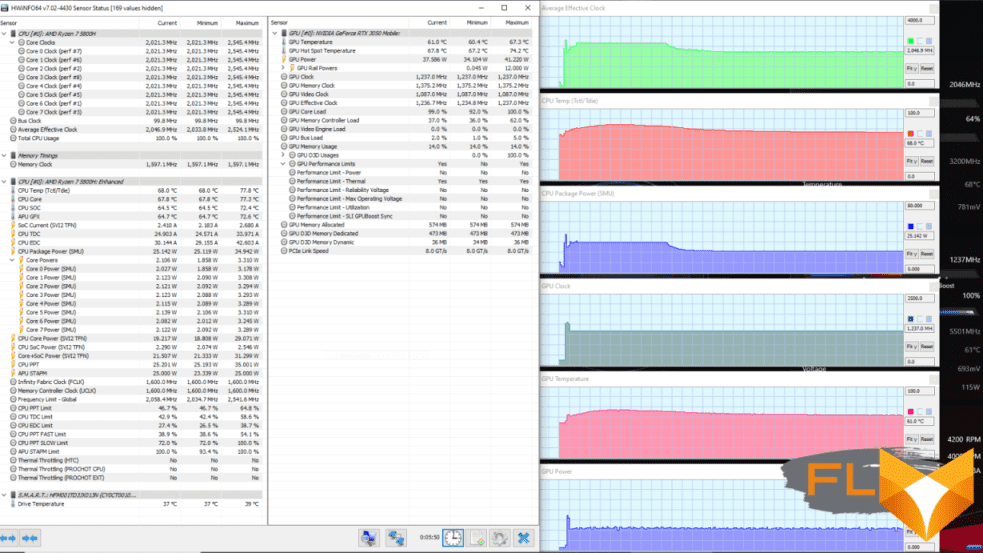
At maximum load simultaneously on the CPU and GPU, the initial surge is noticeable on both the central processor and the video card. For the first, it reaches 2.68 GHz in frequency and 44 W in power, for the second – 1.5 GHz and 69 W. The CPU continues to run at 2.52GHz at 35W while the GPU continues at 1.2GHz and 38-41W. After 5 minutes, the automation forcibly reduces the consumption of the central processor to 25 W, “clamping” the clock frequency to 2 GHz with a decrease in the CPU temperature to 68 °C. The coolers operate at a constant speed of 4200/4000 rpm (36 dBA), reaching it 2 minutes after the start of the test. Based on the tests carried out, it seems that the laptop’s cooling system has sufficient resources to cope even with the maximum operating modes of the central processor and video card. A noticeable warm-up – CPU up to 87 °C and GPU up to 82 °C – does not lead to overheating, and the central computer does not reach throttling in any of the modes. The limitations on clock frequency and consumption level introduced by automation are the result of the manufacturer’s desire to reduce the level of noise produced by the cooling system, and this is a completely reasonable and justified decision.
Of course, to achieve maximum performance, you should use the Turbo profile, in which we conducted all the tests of the relevant sections. But in practice, the laptop should be switched to work in the Silent profile immediately after exiting the game or other resource-intensive application, since the cooling system in it works in passive mode most of the time and does not produce noise.
Case heating
Below are thermal images obtained after long-term operation of the laptop under maximum load on the CPU and GPU (Turbo profile):
Under maximum load, working with the keyboard is comfortable, since the places under the wrists do not heat up. Keeping the laptop on your lap is not pleasant, because the knees are partially in contact with areas of high heat. Your knees can also block the intake vents (which is not the case when you place the laptop on a flat hard surface), which can cause the laptop to overheat. Despite all the precautions, overheating can still lead to unpleasant consequences. The power supply gets very hot, so when working for a long time with high performance, you must make sure that it is not covered with anything.
Noise level
We measure the noise level in a special soundproof and semi-dampened chamber. At the same time, the sound level meter microphone is located relative to the laptop in such a way as to imitate the typical position of the user’s head: the screen is tilted back by 45 degrees (or to the maximum, if the screen does not recline by 45 degrees), the microphone axis coincides with the normal emanating from the center of the screen, the front end of the microphone is located at a distance of 50 cm from the plane of the screen, the microphone is directed at the screen. The load is created using the powerMax program, the screen brightness is set to maximum, the room temperature is maintained at 24 degrees, but the laptop is not specially blown, so in the immediate vicinity the air temperature may be higher. In order to estimate the real consumption, we also show (for some modes) the consumption from the network in steady state and the maximum value recorded during this test. The battery is pre-charged to 100%, in the settings of the proprietary utility, the Windows profile is selected, Quiet (Silent), Efficiency (Performance) or Turbo (Turbo).
| Load Scenario | Noise level, dBA | Subjective evaluation | Power consumption, W |
|---|---|---|---|
| Windows profile | |||
| Maximum CPU and GPU load | 39,8 | loud but bearable | 158 (maximum 164) |
| Quiet Profile | |||
| Inactivity | background/21 | conditionally silent/very quiet | 30 |
| Maximum CPU and GPU load | 36,4 | loud but bearable | 118 (maximum 134) |
| Efficiency Profile | |||
| Inactivity | 25,6 | quiet | 35 |
| Max CPU load | 37,6 | loud but bearable | 85 (maximum 108) |
| Maximum GPU load | 39.9 | loud but bearable | 138 (maximum 142) |
| Maximum CPU and GPU load | 39.9 | loud but bearable | 158 (maximum 165) |
| Turbo Profile | |||
| Maximum CPU and GPU load | 43,9 | very loud | 160 (maximum 165) |
If the laptop is not loaded at all, then its cooling system, even in the case of the Quiet profile, still cannot work in passive mode for a long time – the fans turn on periodically for a short time, and this is audible. In case of a heavy load on the processor and / or on the video card, the noise from the cooling system, as well as the performance, depend on the selected profile. The noisiest and most productive is the Turbo profile, and the quietest and least productive is the Quiet profile, which corresponds to their names. The nature of the noise is smooth and not annoying. Note that despite exceeding the 40 dBA threshold, this laptop is not very noisy compared to other gaming laptops.
For a subjective assessment of the noise level, the following scale is applicable:
| Noise level, dBA | Subjective evaluation |
|---|---|
| Less than 20 | conditionally silent |
| 20-25 | very quiet |
| 25-30 | quiet |
| 30-35 | clearly audible |
| 35-40 | loud but bearable |
| Above 40 | very loud |
From 40 dBA and above, the noise, from our point of view, is very high, long-term work with a laptop is difficult, from 35 to 40 dBA the noise level is high, but tolerable, from 30 to 35 dBA the noise is clearly audible, from 25 to 30 dBA noise from the system cooling will not stand out much against the background of typical sounds surrounding a user in an office with several employees and working computers, anywhere from 20 to 25 dBA a laptop can be called very quiet, below 20 dBA – conditionally silent. The scale, of course, is very conditional and does not take into account the individual characteristics of the user and the nature of the sound.
Performance
The laptop uses an AMD Ryzen 7 5800H mobile processor based on the Zen3 microarchitecture (8 cores, 16 threads). The official frequencies are 3.2 / 4.4 GHz, heat dissipation is 45 W (there is a consumption setting in the range of 35-54 W). The main computer has an integrated Radeon RX Vega 8 graphics core, but for games and applications that can use the GPU, a discrete Nvidia GeForce RTX 3050 Laptop graphics card is used.

A 1 TB solid-state drive (SK Hynix HFM001TD3JX013N, M.2) acts as a storage for installed programs and user data.
This time we use the popular application CrystalDiskMark not only to evaluate the read and write speeds of the drive, but also as a stress test to determine the degree of its heating during operation. Therefore, on the substrate we will place the SSD temperature graph in the form in which HWinfo64 tracks it. We tried to arrange the characteristic changes in the SSD temperature graph in such a way that they roughly coincided in time with the corresponding sections of the test performed by CrystalDiskMark 7: read operations are the first warm-up wave of the SSD, write operations are the second wave, and mixed operations are the third.

In the picture, we see that in terms of read and write data speeds in sequential and random modes, the SSD drive of our laptop demonstrates very high performance and is ahead of many fellows in the class, not to mention spindle drives. Its minimum heating at rest, that is, before the activation of the load, is 35 °C. It is clear that the temperature rise to a maximum of 57 °C occurs during the write speed test (the second wave on the graph). Neither this value, nor the average of 47 °C, is of any significance for the physical safety of SSD memory cells and the security of the data stored in them.
Now we will present the results of testing the laptop in real conditions in accordance with the methodology and set of applications of our test suite. The processor in our laptop does not claim to be the leader in the mobile segment, but it still has a very high performance, so we will compare its achievements with the performance of two other laptops on top CPUs: Asus ROG Strix Scar G17 G732 (Intel Core i9-10980HK processor), and also Asus ROG Strix G17 G713QR (AMD Ryzen 9 5900HX processor). For the purposes of traditional comparison, as always, we use a reference system with a 6-core Intel Core i5-9600K.
| Test | Reference result | Asus ROG Strix G17 G713QС (AMD Ryzen 7 5800H) | Asus ROG Strix G17 G713QR (AMD Ryzen 9 5900HX) | Asus ROG Strix Scar G17 G732 (Intel Core i9-10980HK) |
|---|---|---|---|---|
| Video conversion points | 100 | 162 | 157 | 140 |
| MediaCoder x64 0.8.57, c | 132.0 | 76.9 | 78,9 | 88,38 |
| HandBrake 1.2.2, c | 157.4 | 99.3 | 102.5 | 116,9 |
| VidCoder 4.36, c | 385.9 | 249.0 | 258.1 | 286,09 |
| Rendering points | 100 | 173 | 171 | 154 |
| POV-Ray 3.7, c | 98.9 | 57.3 | 58.0 | 70,64 |
| Cinebench R20, c | 122,2 | 65,2 | 67,8 | 80,04 |
| Blender 2.79, c | 152.4 | 97.4 | 98.1 | 101,66 |
| Adobe Photoshop CC 2019 (3D rendering), c | 150,3 | 85,2 | 83,1 | 85,78 |
| Video content creation, points | 100 | 129 | 128 | 136 |
| Adobe Premiere Pro CC 2019 v13.01.13, c | 298.9 | 231,2 | 231.5 | — |
| Magix Vegas Pro 16.0, c | 363.5 | 374,1 | 385.0 | 252,67 |
| Magix Movie Edit Pro 2019 Premium v.18.03.261, c | 413,3 | 277,9 | 293,7 | — |
| Adobe After Effects CC 2019 v 16.0.1, с | 468,7 | 291,0 | 276,3 | 308,67 |
| Photodex ProShow Producer 9.0.3782, c | 191,1 | 160,1 | 160,5 | 165,08 |
| Digital photo processing, points | 100 | 133 | 132 | 148 |
| Adobe Photoshop CC 2019, s | 864.5 | 721.0 | 721.7 | 733,78 |
| Adobe Lightroom Classic CC 2019 v16.0.1, c | 138.5 | 125.7 | 153.0 | 92,08 |
| Phase One Capture One Pro 12.0, c | 254.2 | 141,2 | 141,2 | 137,84 |
| Text recognition score | 100 | 173 | 204 | 177 |
| Abbyy FineReader 14 Enterprise, c | 492.0 | 284.0 | 241,2 | 278,17 |
| Archiving, points | 100 | 143 | 132 | 203 |
| WinRAR 5.71 (64-bit), c | 472,3 | 329.8 | 339,2 | 233,92 |
| 7-Zip 19, c | 389.3 | 271.3 | 312,1 | 190,68 |
| Scientific calculations, points | 100 | 135 | 144 | 134 |
| LAMMPS 64-bit, c | 151.5 | 113,7 | 103.7 | 104,52 |
| NAMD 2.11, c | 167.4 | 104.0 | 109,2 | 125,18 |
| Mathworks Matlab R2018b, c | 71,1 | 52,4 | 47.0 | 61,71 |
| Dassault SolidWorks 2018 SP05 + Flow Simulation, c | 130,0 | 112,4 | 102.5 | 89 |
| Integral result without accumulator, points | 100 | 149 | 151 | 154 |
| WinRAR 5.71 (Store), c | 78.0 | 20,1 | 20,6 | 20,47 |
| Data copying speed, c | 42,6 | 8,8 | 8,3 | 9,18 |
| Integral result of the accumulator, points | 100 | 434 | 440 | 421 |
| Integral performance result, points | 100 | 205 | 208 | 209 |
As you can see, in terms of the integral performance indicator, our laptop is only slightly inferior to rivals based on top mobile AMD and Intel processors, and even surpasses the Asus ROG Strix Scar G17 G732 in terms of the integral result of the drive. This means that our hero is a worthy competitor to more expensive models in terms of professional creative work (but not games), and if we keep in mind the classic model of using laptops, then taking into account almost the same overall performance, its advantages are seriously enhanced by a more forgiving price.
Testing in games
We conducted gaming testing of the laptop using its discrete Nvidia GeForce RTX 3050 Laptop graphics card. This is the most modest video solution in the Nvidia 30 line in terms of performance, inferior to older models not only in terms of the number of CUDA cores and the maximum amount of video memory (only 4 GB), but also in terms of the memory bus width (128 bits).
The GeForce RTX 30 mobile video cards, based on the Ampere architecture, were announced relatively recently, at the beginning of January 2021. And the model that our hero has is generally on May 11, 2021. Nvidia indicates only the limits of the performance range for laptop video cards, while while the performance of these solutions as part of a specific configuration must be determined by laptop manufacturers.
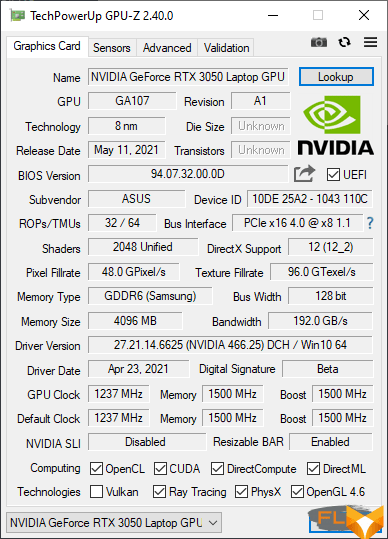
Let’s see how the laptop handles a range of modern games at 1920×1080 resolution with the most demanding graphics settings, including ray tracing enabled, and compare its gaming performance with Asus TUF Gaming A15 FX506IV laptops (AMD Ryzen 7 4800H, 32 GB RAM, Nvidia GeForce 2060 with 6GB GDDR6) and Gigabyte Aero 15 OLED XC (Intel Core i7-10870H, 32GB RAM, Nvidia GeForce RTX 3070 with 8GB GDDR6) at the same screen resolution. The data of testing by the built-in benchmarks of the corresponding games with “ultra” presets are given in the table below, where the average and minimum fps are indicated through a fraction.
| Game, preset and/or Ultra settings | Asus ROG Strix G17 G713QC (Nvidia GeForce RTX 3050) | Asus TUF Gaming A15 FX506IV (Nvidia GeForce RTX 2060) | Gigabyte Aero 15 OLED XC (Nvidia GeForce RTX 3070) |
|---|---|---|---|
| World of Tanks (Ultra, RT) | 96/61 | 100/64 | 148/100 |
| Far Cry 5 (Ultra) | 83/65 | 91/79 | 112/88 |
| Tom Clancy’s Ghost Recon Wildlands (Ultra) | 40/33 | 49/43 | 67/57 |
| Metro: Exodus (Ultra) | 37/20 | 45/26 | 66/32 |
| Metro: Exodus (Ultra, RT) | 33/19 | 34/22 | 55/31 |
| Metro: Exodus (Ultra, RT, DLSS) | DLSS not enabled | ||
| Shadow of the Tomb Raider | 78/57 | 79/60 | 81/61 |
| Shadow of the Tomb Raider (RT) | 46/31 | 45/29 | 61/51 |
| Shadow of the Tomb Raider (RT, DLSS) | 51/36 | 50/34 | 67/54 |
| World War Z | 118/102 | 116/100 | 159/133 |
| Deus Ex: Mankind Divided | 62/51 | 61/49 | 77/60 |
| F1 2018 | 97/70 | 90/78 | 127/100 |
| Strange Brigade | test freezes | 116/81 | 175/85 |
| Assassin’s Creed Odyssey | 44/22 | 49/35 | 71/35 |
| Borderlands 3 | 41 | 49 | 76 |
| Gears 5 | 66/48 | 72/56 | 99/80 |
| A Total War Saga: Troy | 33/27 | — | 68/56 |
| Horizon Zero Dawn | 40/21 | — | 85/45 |
Of course, playable indicators, that is, 60/30 fps or more, were found in 7 games out of 18. Metro: Exodus and Assassin’s Creed Odyssey should be recognized as unplayable – not only theoretically (due to low fps), but also practically (due to periodically the resulting slowdowns of the picture). Of course, this can be fixed at the cost of traditional compromises: lower anti-aliasing, reduce texture detail, complexity of shadows, reflections, etc. Therefore, we tested performance in games not only at maximum, but also at lower settings (High instead of Ultra) and again compared the figures obtained with the mentioned laptop Asus TUF Gaming A15 FX506IV.
| Game, preset and/or High settings | Asus ROG Strix G17 G713QC (Nvidia GeForce RTX 3050) | Asus TUF Gaming A15 FX506IV (Nvidia GeForce RTX 2060) |
|---|---|---|
| World of Tanks | 192/118 | 206/132 |
| Far Cry 5 | 93/81 | 95/84 |
| Tom Clancy’s Ghost Recon Wildlands | 79/67 | 85/74 |
| Metro: Exodus | 50/28 | 55/30 |
| Metro: Exodus (RT) | 38/22 | 41/25 |
| Metro: Exodus (RT, DLSS) | 40/23 | DLSS not included |
| Shadow of the Tomb Raider | 89/69 | 87/68 |
| Shadow of the Tomb Raider (RT) | 54/36 | 52/34 |
| Shadow of the Tomb Raider (RT, DLSS) | 58/40 | 57/39 |
| World War Z | 127/107 | 122/105 |
| Deus Ex: Mankind Divided | 78/65 | 83/68 |
| F1 2018 | 144/122 | 148/123 |
| Strange Brigade | 127/89 | 134/96 |
| Assassin’s Creed Odyssey | 68/39 | 73/44 |
| Borderlands 3 | 62 | 64 |
| Gears 5 | 87/68 | 90/73 |
| A Total War Saga: Troy | 79/68 | — |
| Horizon Zero Dawn | 71/29 | — |
The compromise announced above led to a correction of the situation: almost all games became playable. The exception is the same Metro: Exodus, the situation with which has improved only slightly (and the performance still does not meet the conditional standard of 60/30 fps).
Compared to other laptops whose performance is presented in the tables, our hero, unfortunately, is inferior not only to the Gigabyte Aero 15 OLED XC with a more powerful Nvidia GeForce RTX 3070 graphics card of the same series, but also to the Asus TUF Gaming A15 FX506IV with Nvidia GeForce RTX 2060 the previous generation.
It turns out that the Nvidia GeForce RTX 3050 turned out to be the weakest laptop video card not only among the GeForce RTX 30, but also among the GeForce RTX series in general. This is understandable and, in principle, corresponds to the nomenclature of Nvidia accelerators. However, each new generation of video solutions turns out to be faster than the previous one, so the GeForce RTX 3050 shows gaming performance indicators almost at the level of the GeForce RTX 2060, yielding very little to it in most games, and in a couple of games where performance seems to have been raised in new versions of video drivers, even catching up and slightly bypassing it. If we talk about absolute values, then using the GeForce RTX 3050, you can play in Full HD resolution (the card is clearly not designed for 4K) at high and sometimes even maximum graphics settings (depending on the specific game).
Conclusion
The Asus ROG Strix G17 G713QC features a high-performance processor, the highest 32GB RAM seen today, and a 1TB SSD. It has a new budget gaming graphics card Nvidia GeForce RTX 3050 Laptop with 4 GB GDDR6 with the lowest performance in the GeForce RTX 30 series. All this makes the machine, if not the most desirable tool, but definitely the most rational budget gaming decision.
Our hero has a real gaming display with a refresh rate of 300 Hz and a response time of 3 ms. Even if the resolution is only 1920×1080, this is quite enough for gaming comfort, and laptops still cannot afford sports performance at 4K and above. The processor and video card demonstrate good performance, and a rationally arranged cooling system allows them to do this. Of course, the fans are quite noisy at maximum loads, but this is understandable, justified, and simply necessary to ensure adequate performance.
Our test results show that the laptop copes with “heavy” software applications very well, therefore it is very attractive as a tool for creating and editing digital media content.
Based on the study of the new Nvidia GeForce RTX 3050 graphics card, we emphasize that this is an almost ideal solution for budget gaming laptops – namely real ones, and not those to which the word “gaming” is added in order to increase sales. The novelty provides excellent playability in the standard Full HD screen resolution for such machines with at least high quality graphics and allows you to see the ray tracing technology in action.
FAQ Asus rog strix g713qc gaming laptop review
What are the main features of the ROG Strix G17 G713?
The ROG Strix G17 G713 is a powerful gaming laptop featuring an FHD display, per-key RGB lighting, and is powered by an AMD Ryzen™ 9 5900HX CPU and GeForce RTX™ 3070 GPU. It’s designed for gamers seeking an immersive gaming experience with advanced specs like USB 3.2 Gen support.
How does the turbo mode enhance the gaming experience on the ROG Strix G17 G713?
Turbo mode on the ROG Strix G17 G713 elevates the core Windows 10 Pro gaming experience by boosting the performance of both the CPU and GeForce GPU, making it ideal for demanding games and software.
Can the ROG Strix G17 G713 be considered a powerful gaming laptop?
Yes, the ROG Strix G17 G713 is a powerful gaming laptop, thanks to its overclockable AMD Ryzen™ 9 5900HX CPU and GeForce RTX™ 3070 GPU, which deliver high performance for gaming and multitasking.
What type of USB ports are available on the ROG Strix G17 G713?
The ROG Strix G17 G713 includes USB 3.2 Gen ports, offering fast data transfer speeds, which are beneficial for gamers and users who frequently transfer large files.
How does the laptop GPU in the ROG Strix G17 G713 contribute to its gaming performance?
The laptop GPU in the ROG Strix G17 G713, specifically the GeForce RTX™ 3070, significantly contributes to its gaming performance by providing excellent graphics rendering capabilities, essential for a high-quality gaming experience.
What do customer reviews generally say about the ROG Strix G17 G713?
Customer reviews of the ROG Strix G17 G713 generally highlight its impressive gaming performance, durable build, and the quality of its FHD display, making it a favorite among gamers.
How does the ROG Strix G17 G713 compare to the Strix Scar 17?
The ROG Strix G17 G713 and Strix Scar 17 are both part of the ASUS gaming laptops|ROG lineup, but the Strix G17 G713 is often praised for its balance between performance and portability, while the Strix Scar 17 is known for its higher-end specs and is more suited for hardcore gamers.
Are there options to upgrade your Strix G17 for a better gaming experience?
Yes, you can upgrade your Strix G17 with additional RAM or a higher capacity SSD to improve the gaming experience, making it a more versatile laptop for gaming and other demanding tasks.
What makes the ROG Strix G17 G713 stand out in terms of its gaming style?
The ROG Strix G17 G713 stands out in its gaming style with its metallic ROG logo, per-key RGB lighting, and sleek design, appealing to gamers who want a laptop that looks as good as it performs.
Does the ROG Strix G17 G713 feature any advanced audio technology?
Yes, the ROG Strix G17 G713 features advanced two-way AI noise cancellation technology, which works with any input device and enhances the gaming experience by providing clearer communication and immersive sound quality.
What sets the ROG Strix G series apart in the gaming laptop market?
The ROG Strix G series is renowned for its high-performance hardware, such as the RTX 3060 GPU, making it a top choice for gamers seeking a powerful and reliable gaming machine.
How does the RTX 3060 enhance the gaming experience in the ROG Strix G laptops?
The RTX 3060 GPU in the ROG Strix G laptops delivers exceptional graphics performance, enabling smooth and immersive gaming runs with high-quality visual details.
What are some notable features mentioned in the ASUS ROG Strix G17 G713 review?
Reviews of the ASUS ROG Strix G17 G713 often highlight its impressive 17.3-inch gaming laptop display, powerful GeForce RTX™ 3070 GPU, and the advanced cooling system, making it a highly recommended gaming device.
Why is the ROG Strix G17 G713 considered a favorite gaming gear among gamers?
Gamers favor the ROG Strix G17 G713 for its combination of robust performance, striking RGB gaming aesthetics, and the reliability associated with the Republic of Gamers brand.
How is the ROG Backpack designed to complement the ROG Strix G laptops?
The ROG Backpack is specifically designed to safely transport ROG Strix G laptops, featuring spacious compartments and sturdy construction, ideal for mobile gaming enthusiasts.
What advantages do GeForce RTX™ 30 series laptops have for gaming?
GeForce RTX™ 30 series laptops, like the Strix G15, offer cutting-edge graphics capabilities with ray tracing technology, ensuring top-tier gaming performance and visually stunning experiences.
How do video reviews and media reviews impact the perception of the ROG Strix G series?
Video and media reviews provide in-depth analysis and demonstrations of the ROG Strix G series, helping potential buyers understand their gaming and performance capabilities, thereby influencing purchasing decisions.
What specific gaming features does the Strix G17 offer?
The Strix G17 comes equipped with a powerful GeForce RTX™ 3070 GPU, an extended and reshaped keyboard for greater control, and function keys that are spaced for intuitive gaming, making it a top-tier gaming laptop.
How does the ROG Strix G series cater to both laptop and phone gaming needs?
The ROG Strix G series laptops offer advanced connectivity options, allowing seamless integration with mobile gaming through compatible devices and also with downstream peripherals, enhancing the overall gaming ecosystem.
What are the new customizations and details added in the latest Strix G17?
The latest Strix G17 features innovative customizations such as enhanced RGB lighting, user-friendly software for performance tuning, and a design that allows for easy upgrades, appealing to gamers who like to personalize their gaming gear.



















